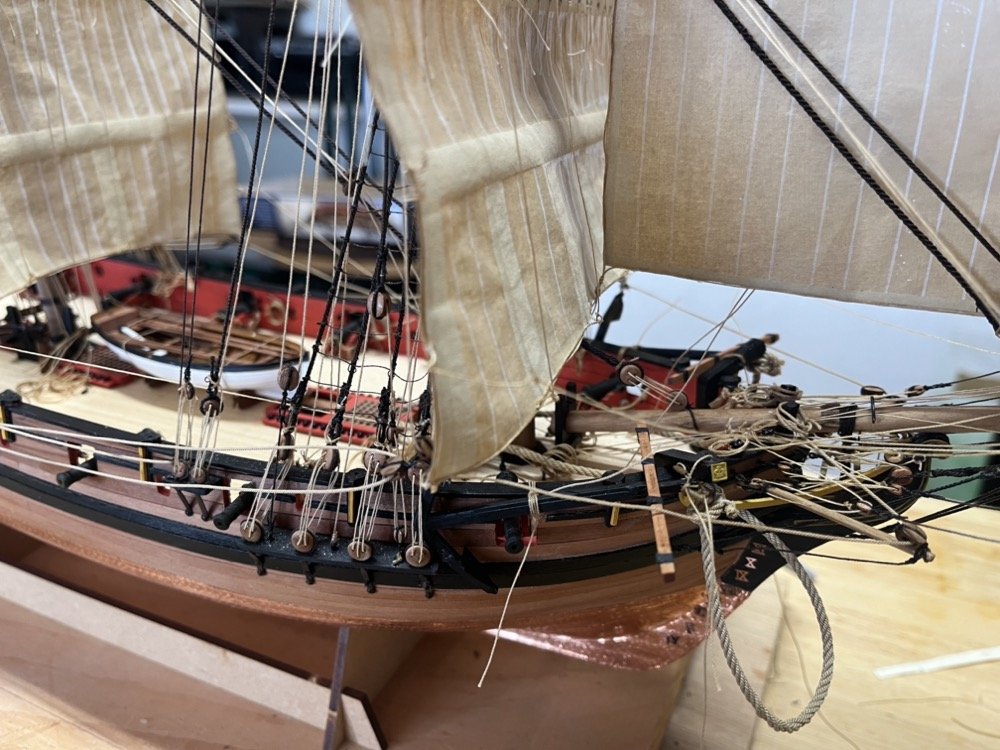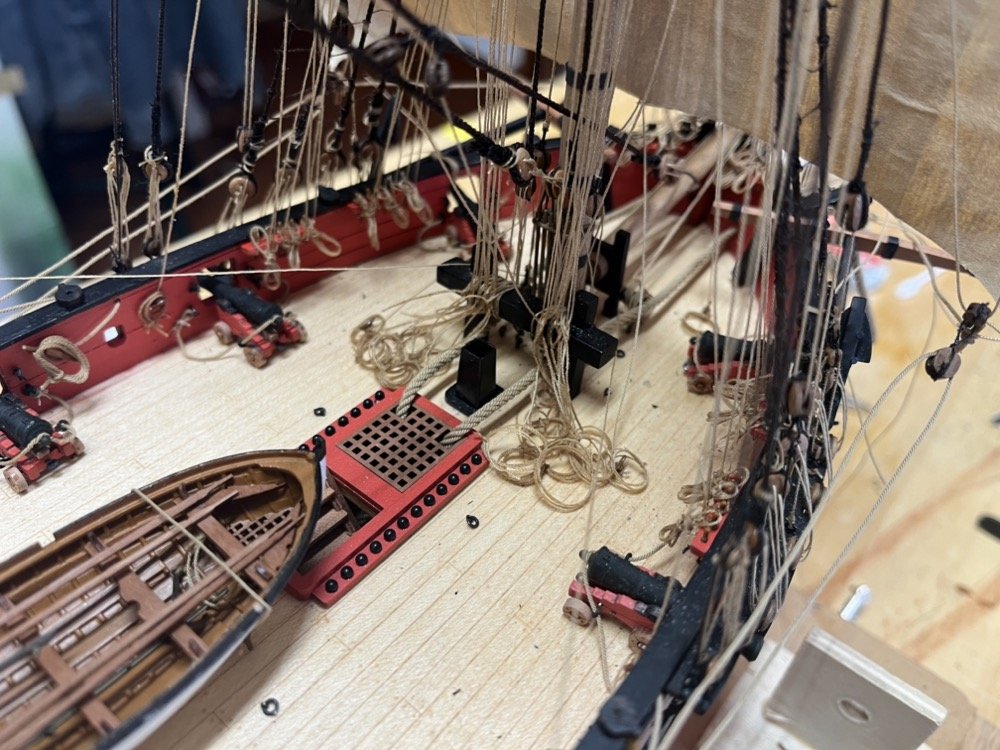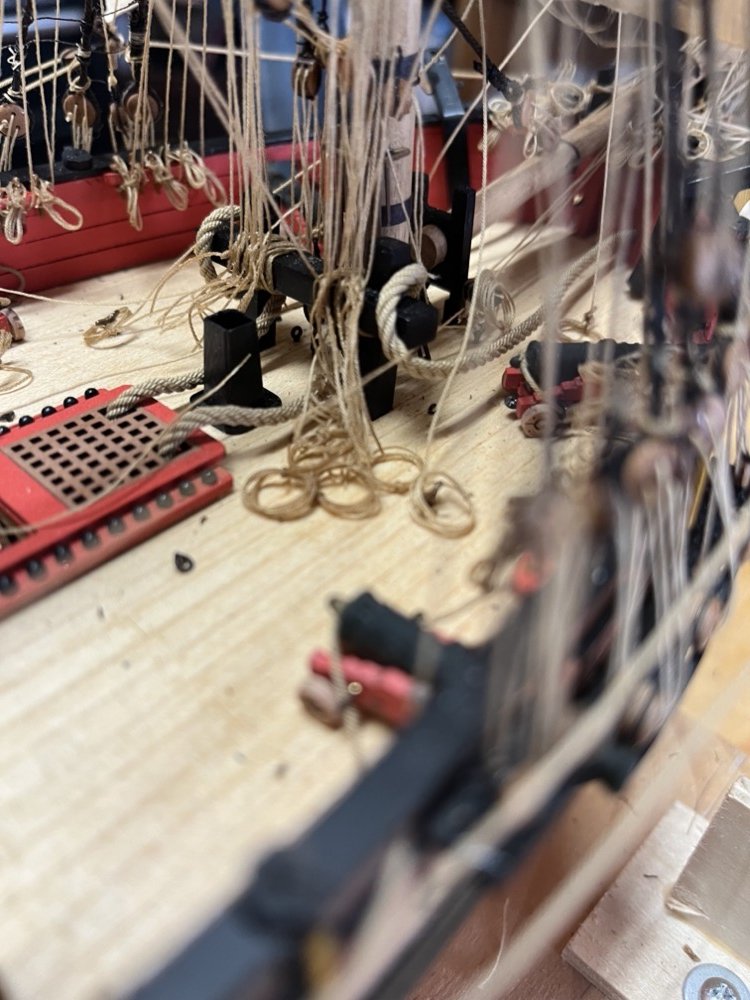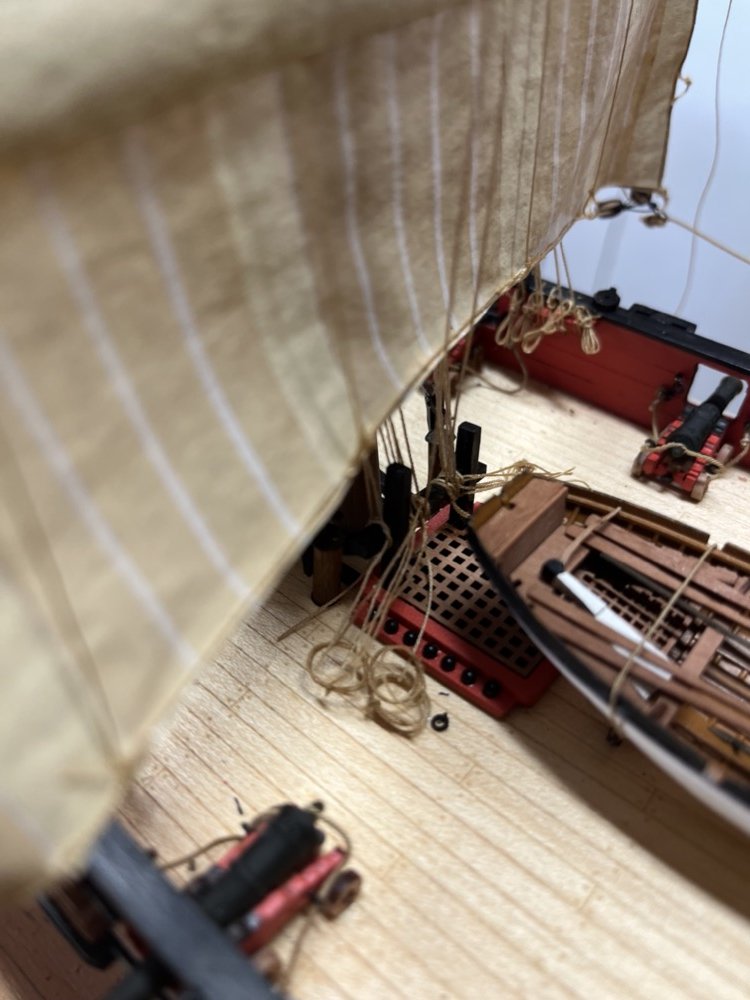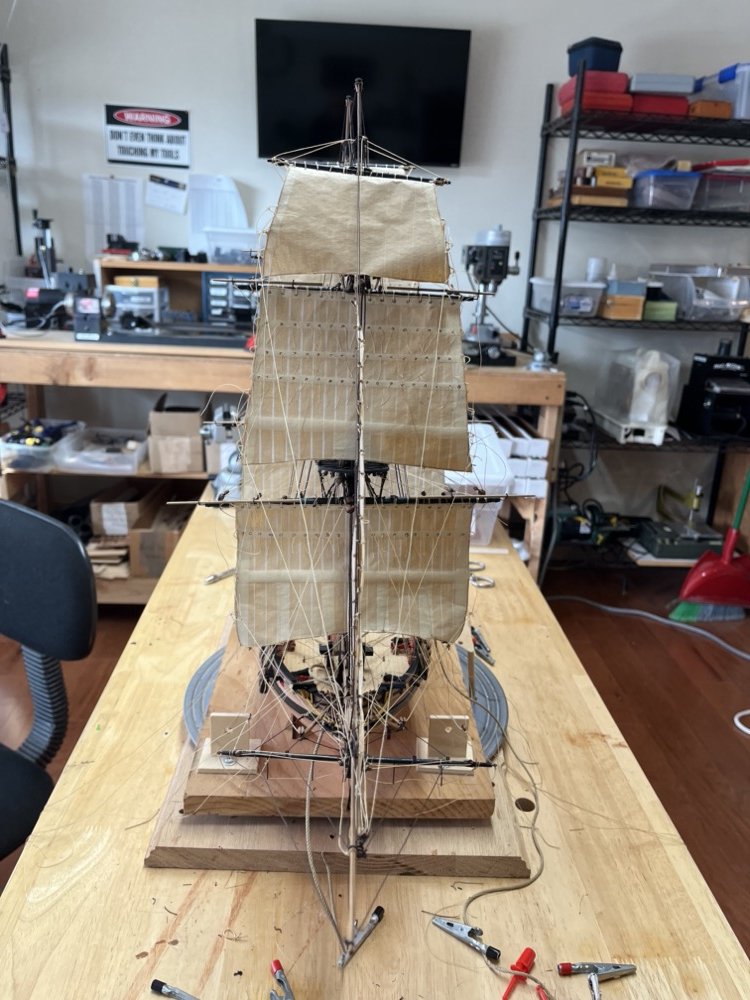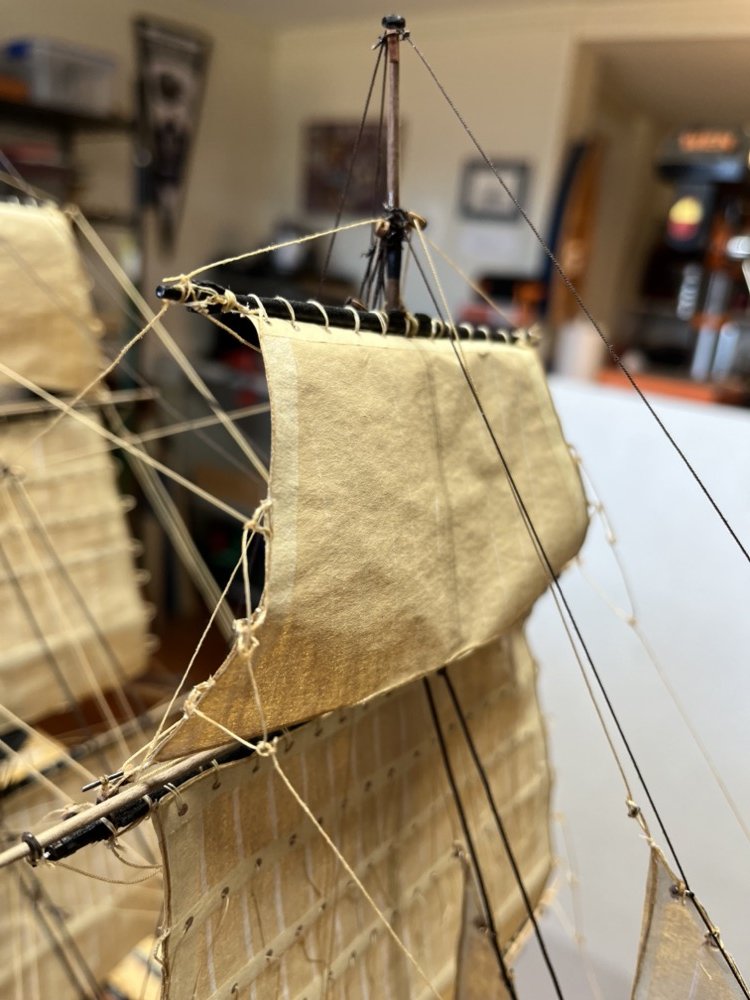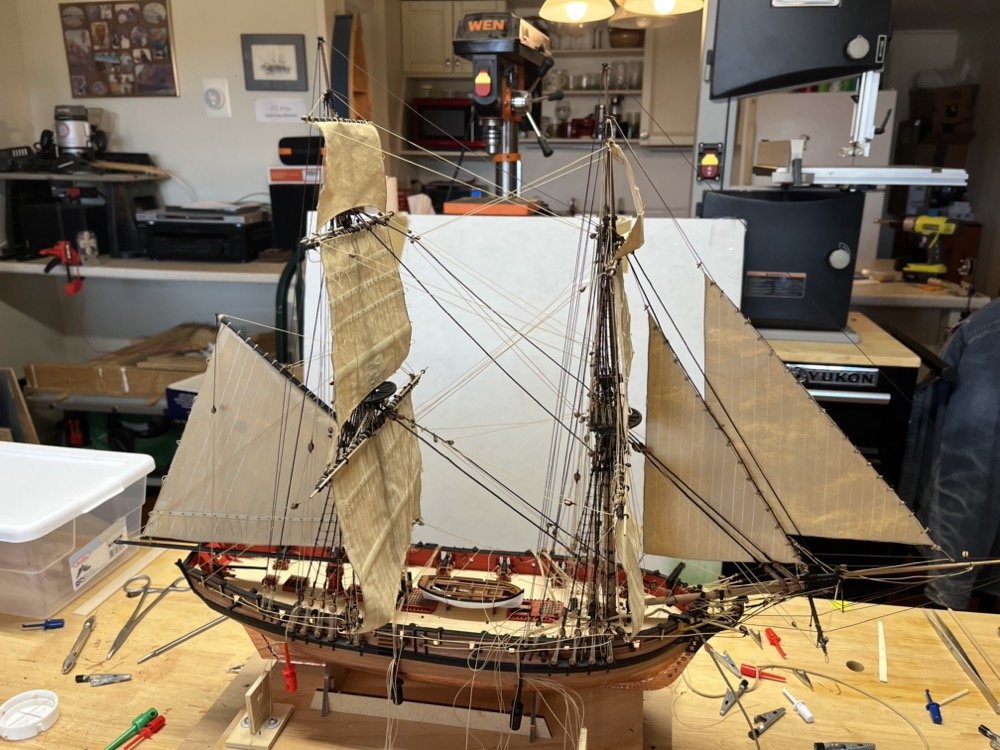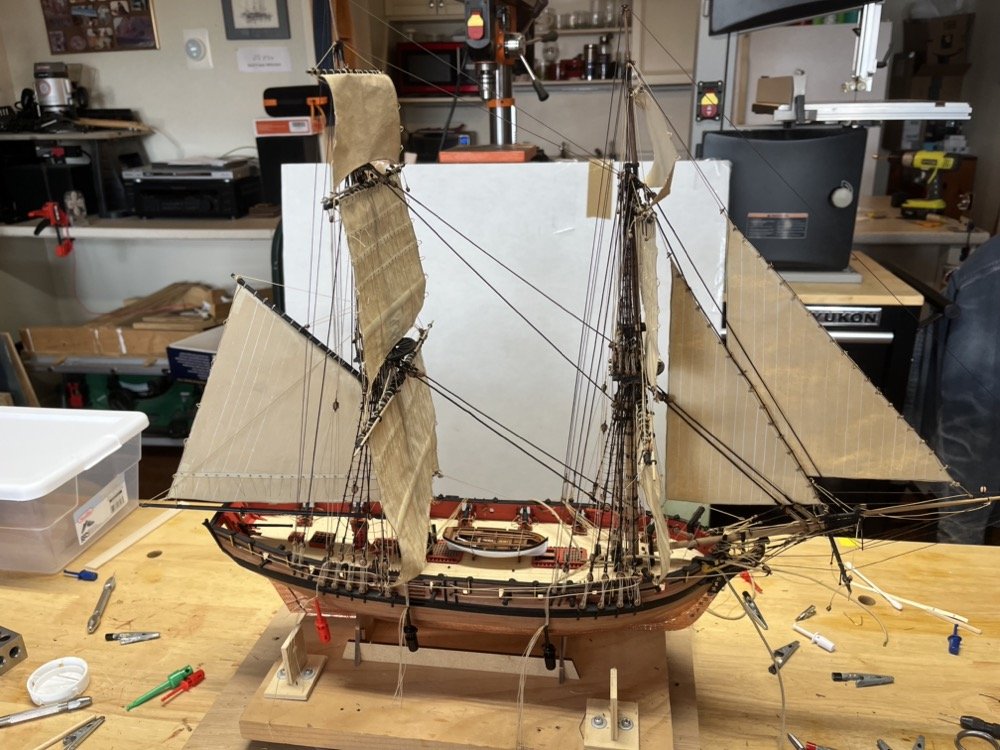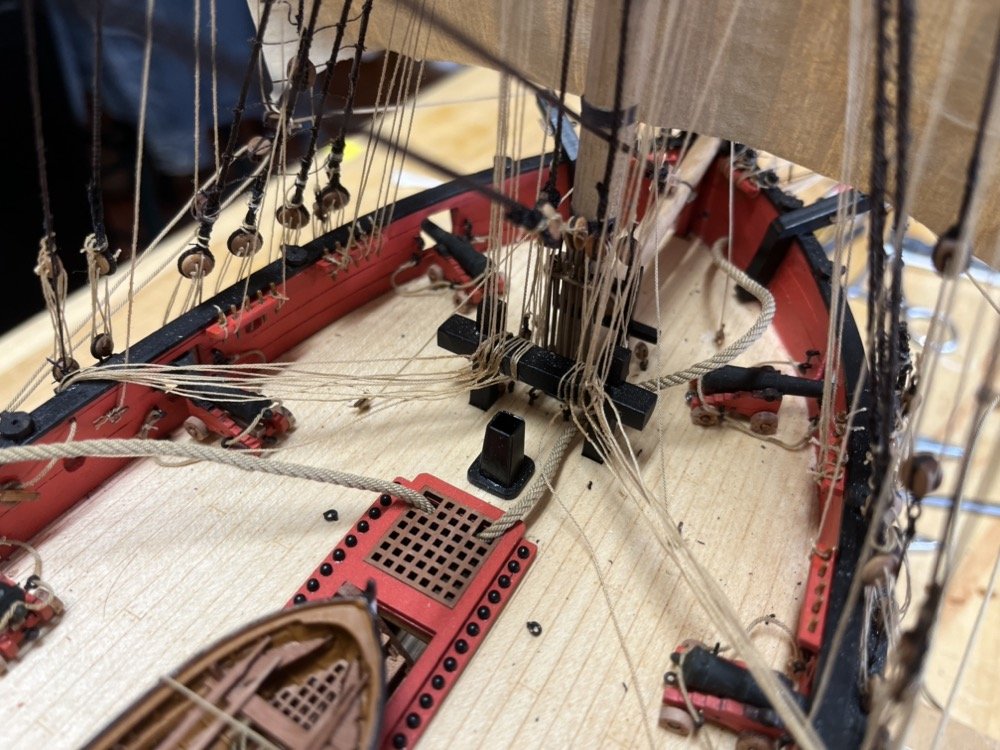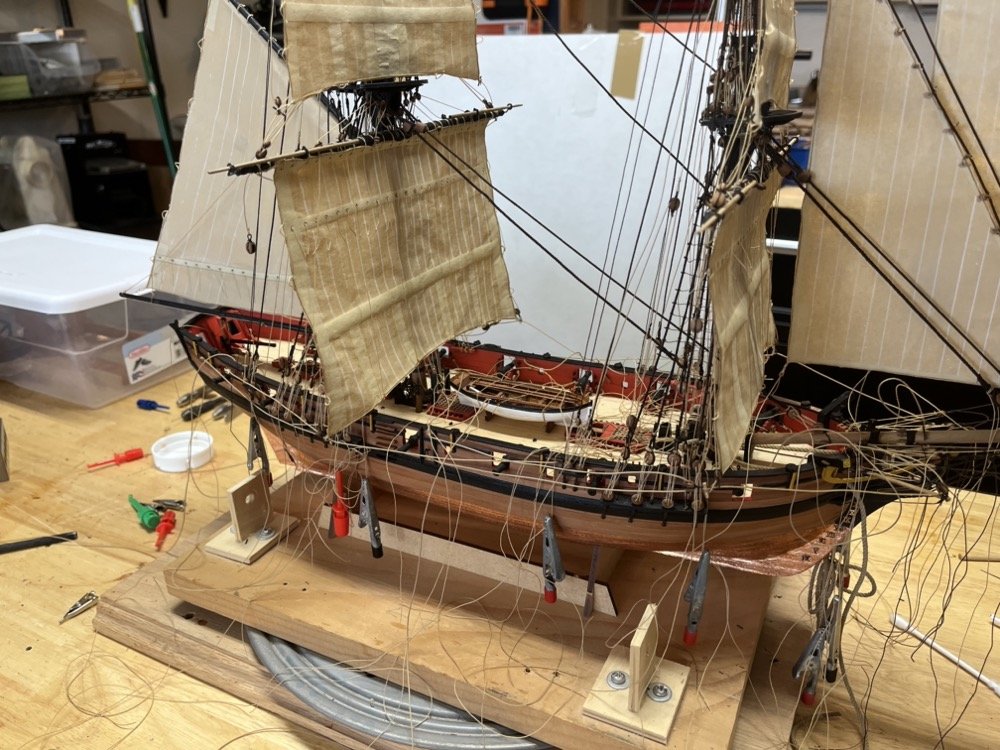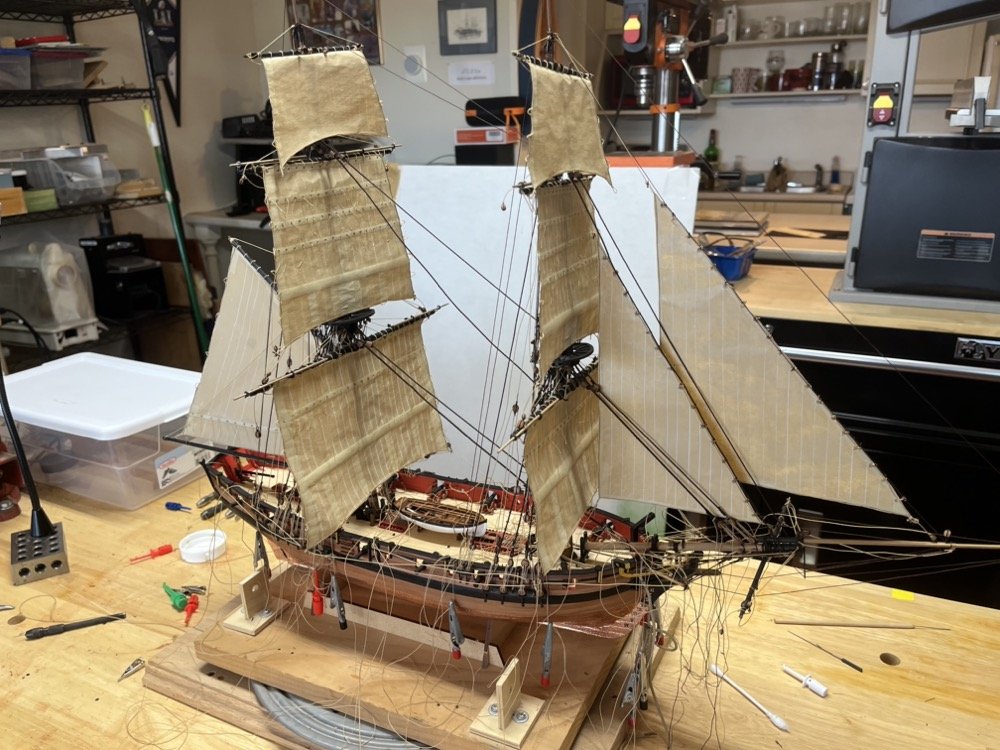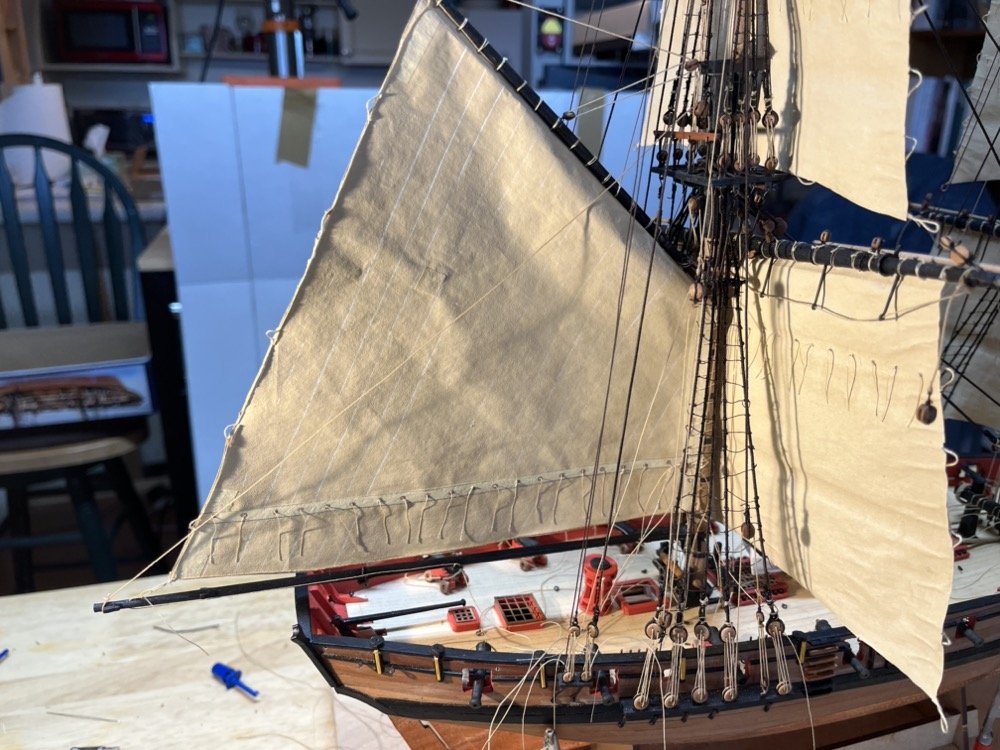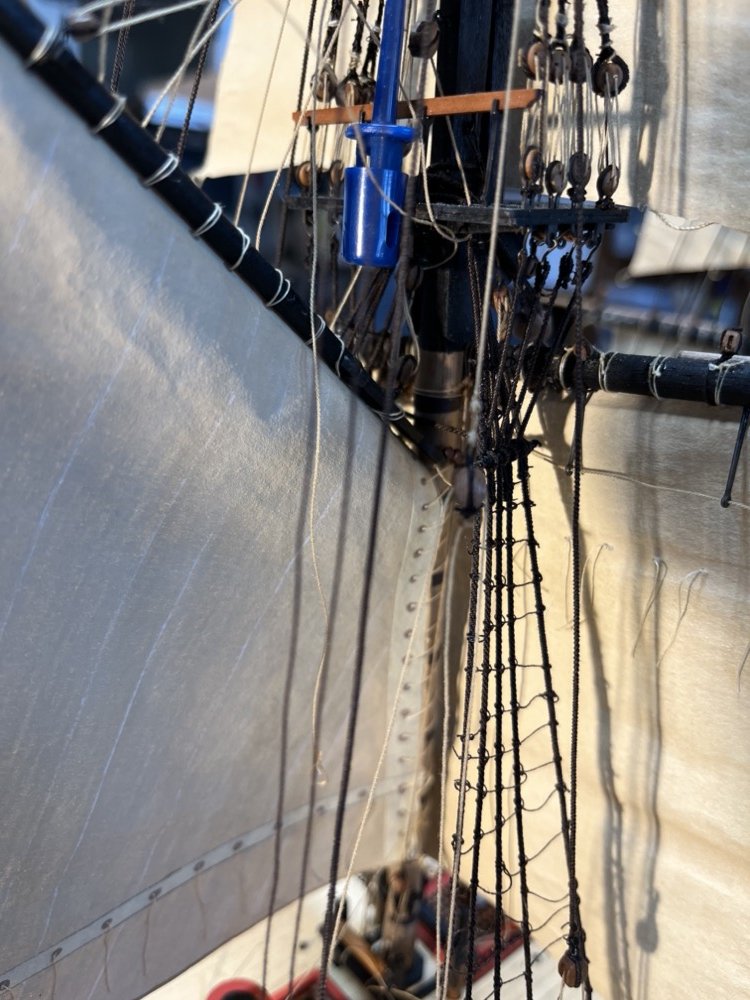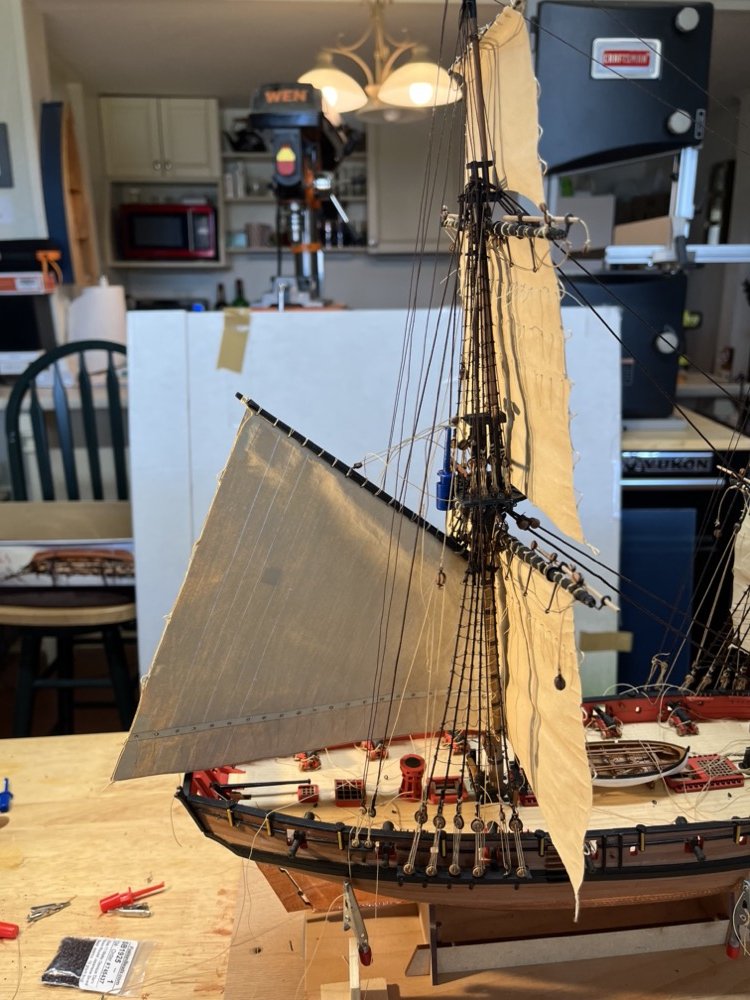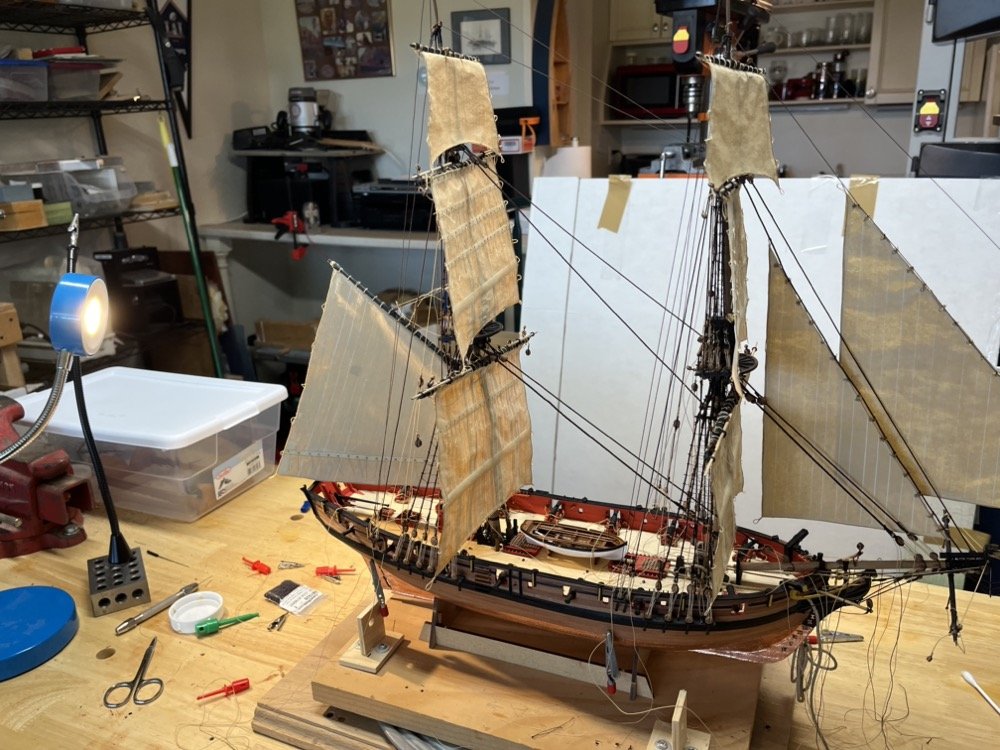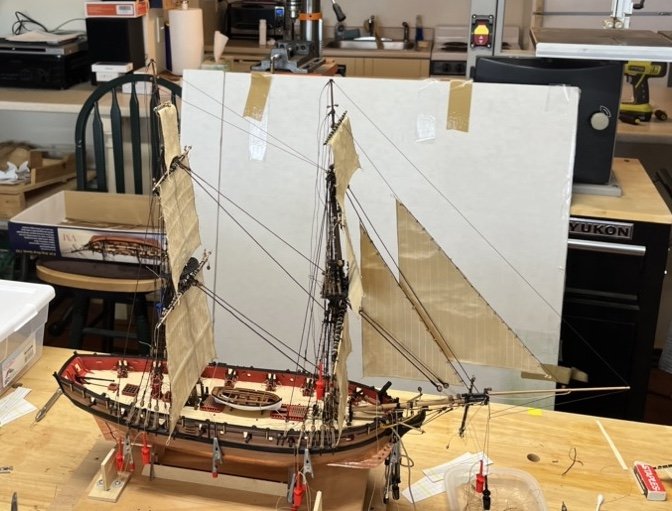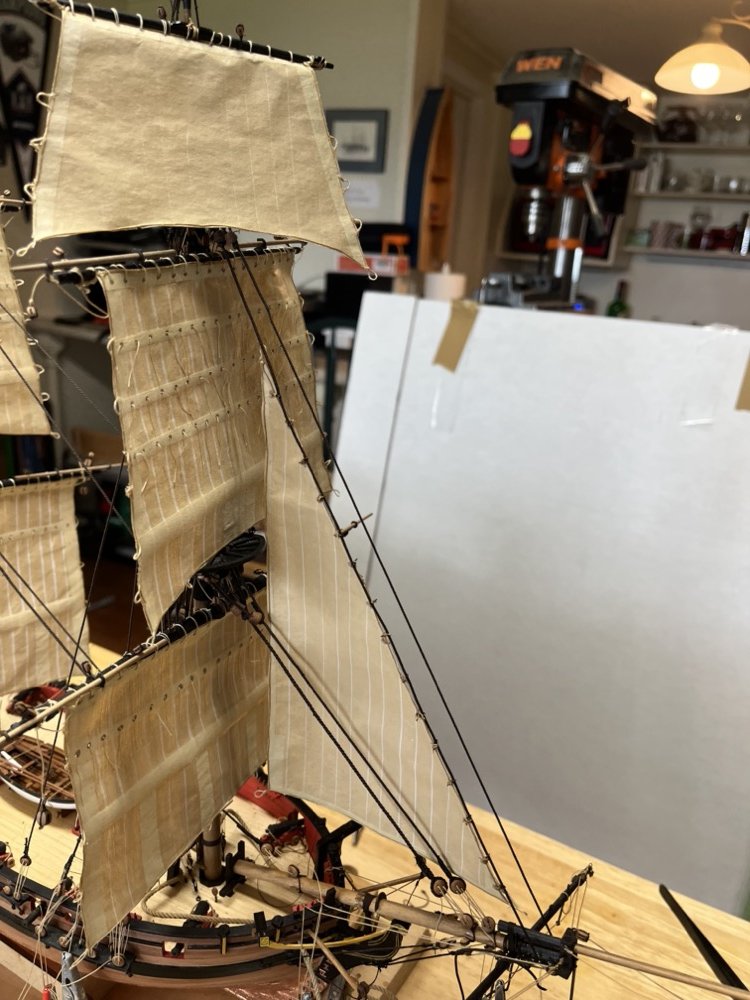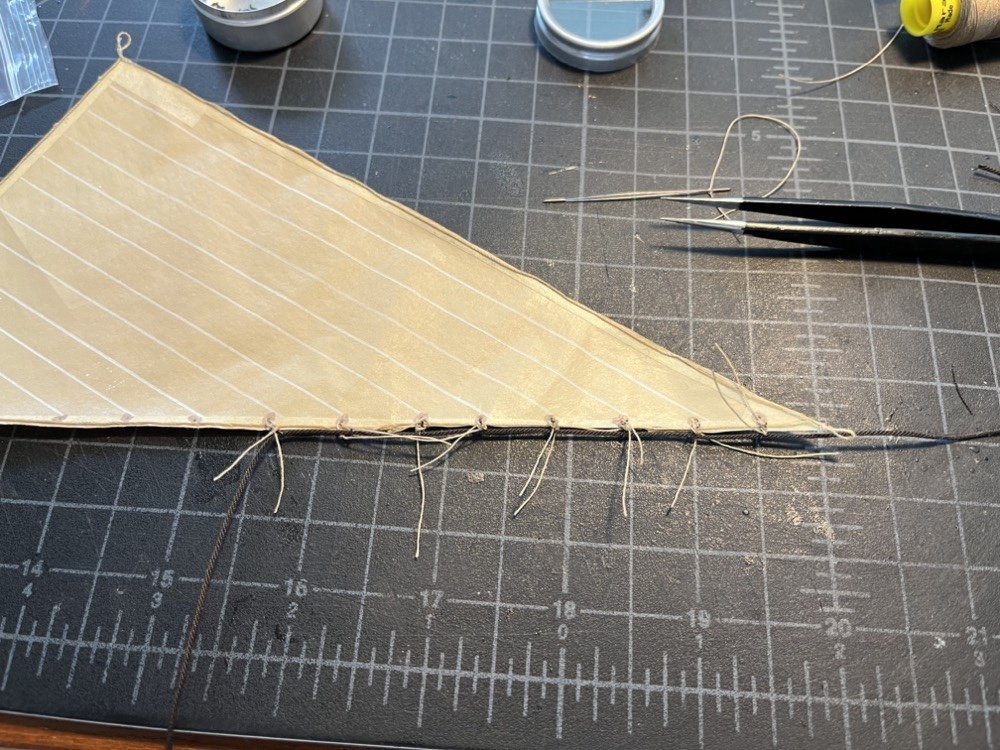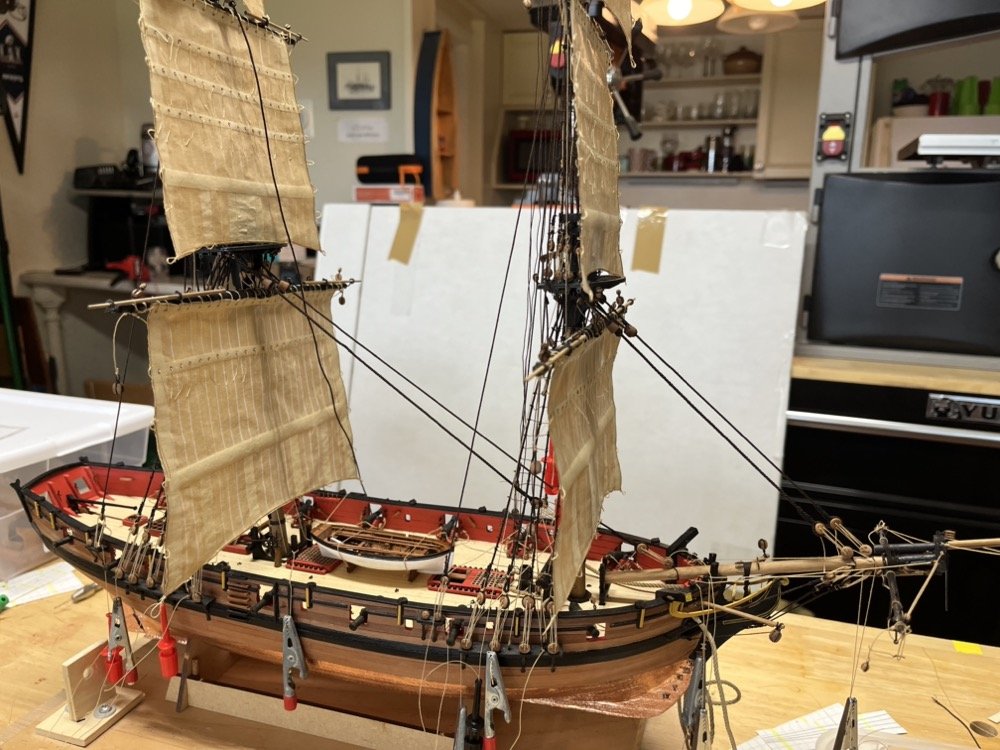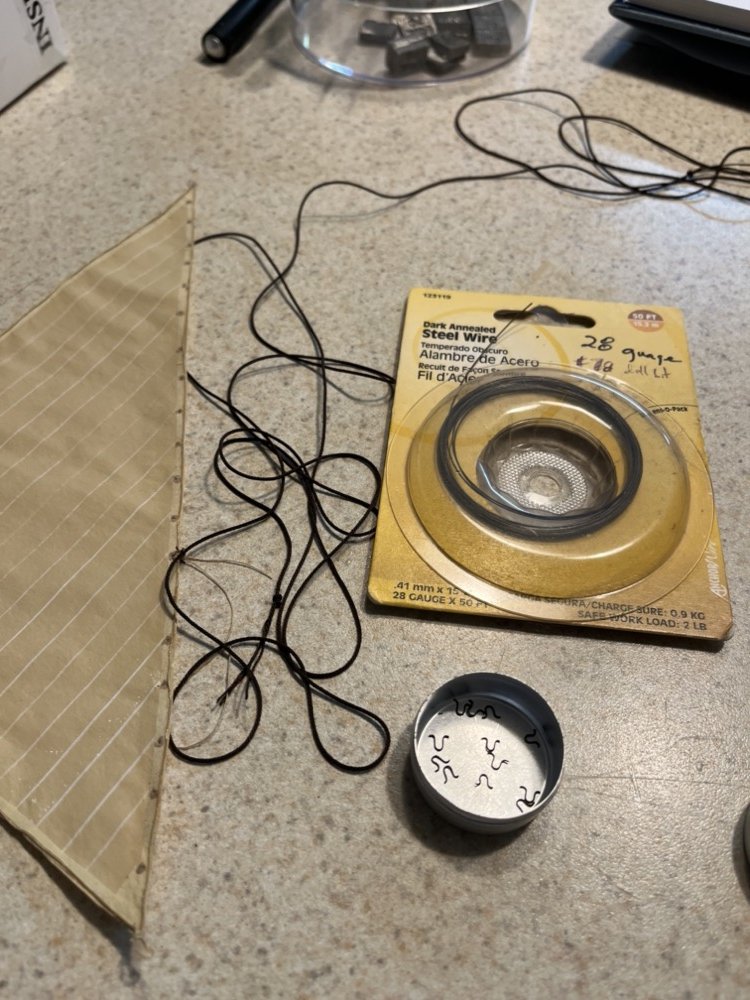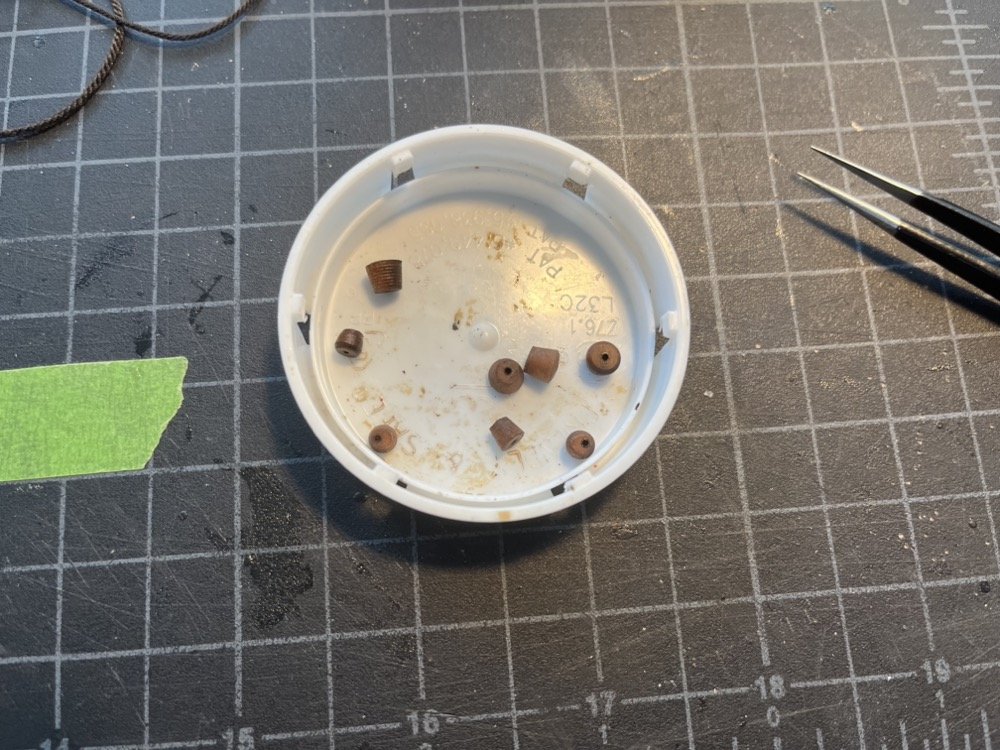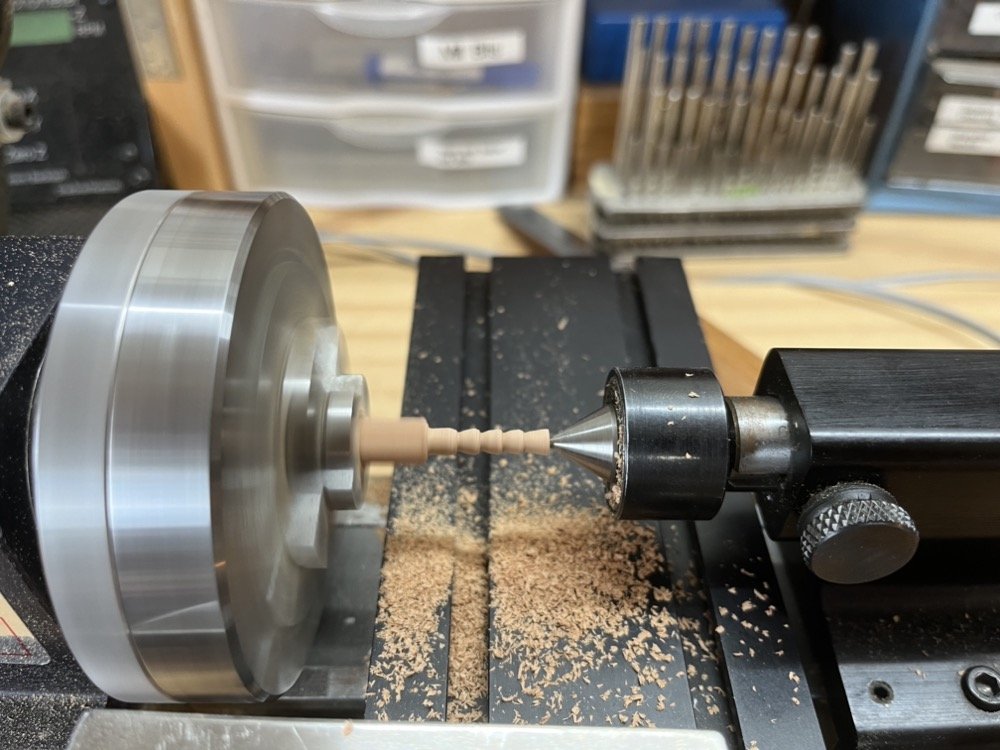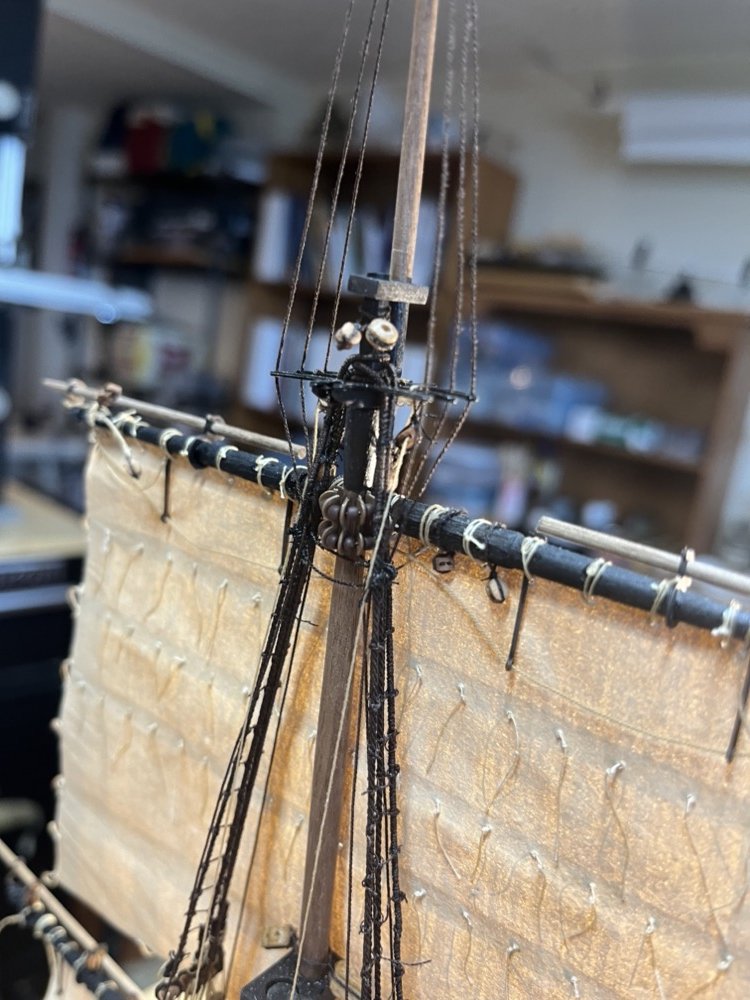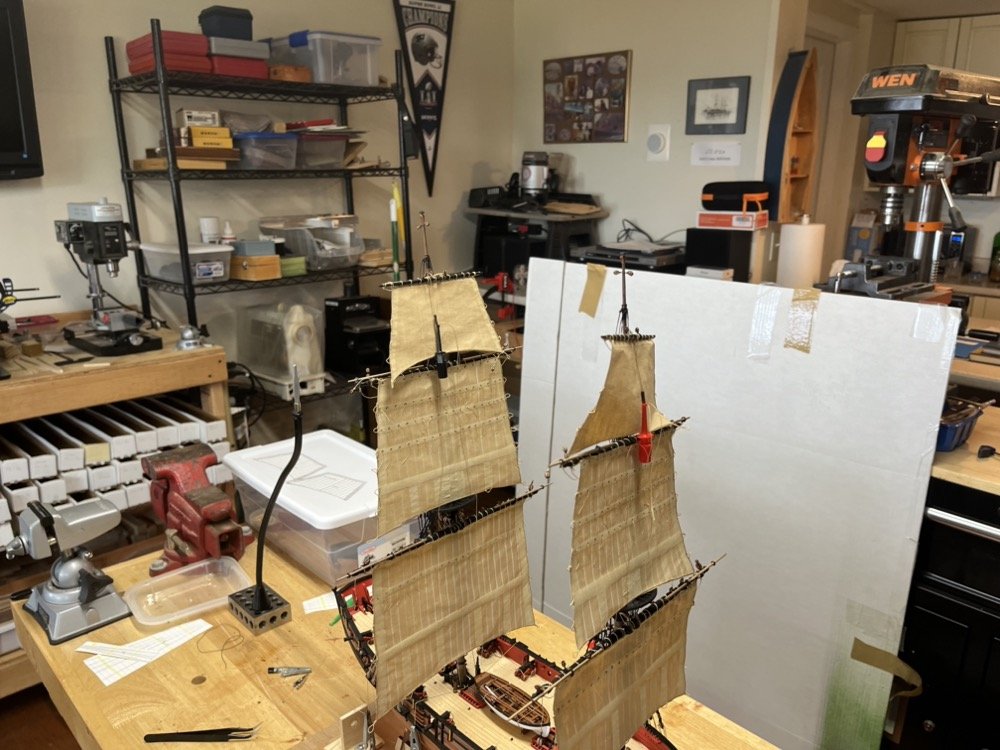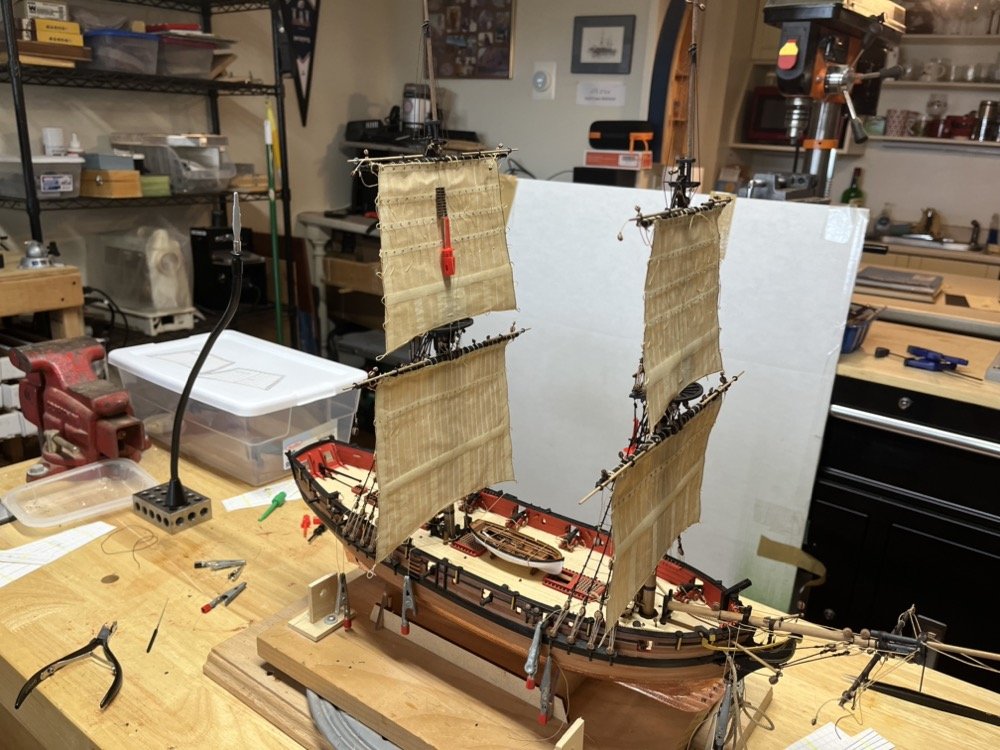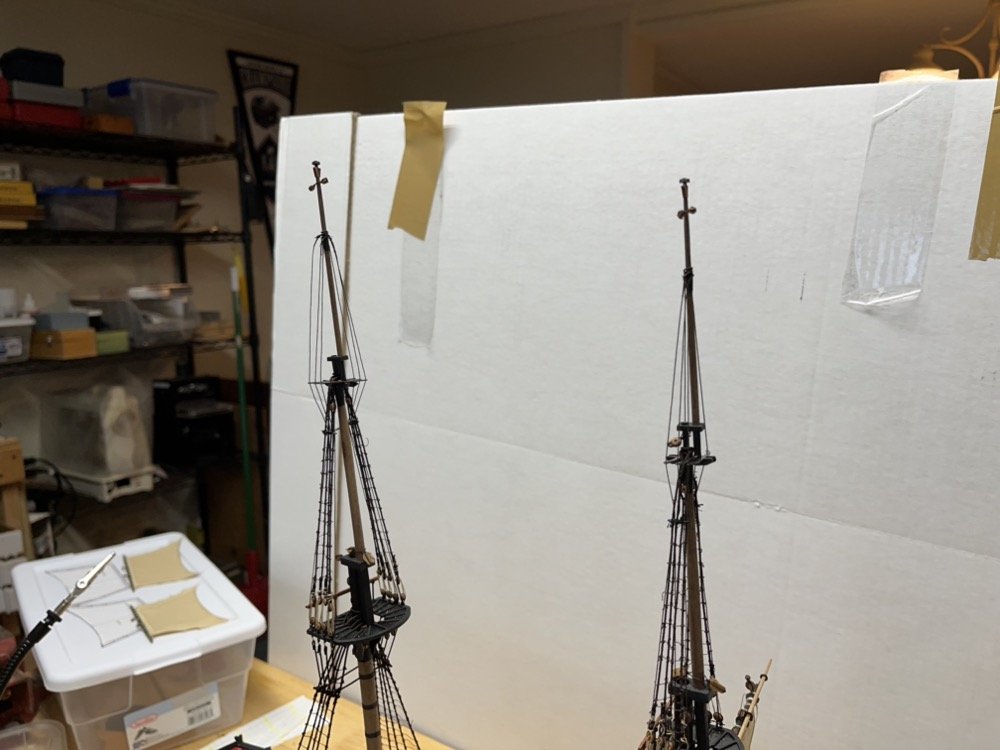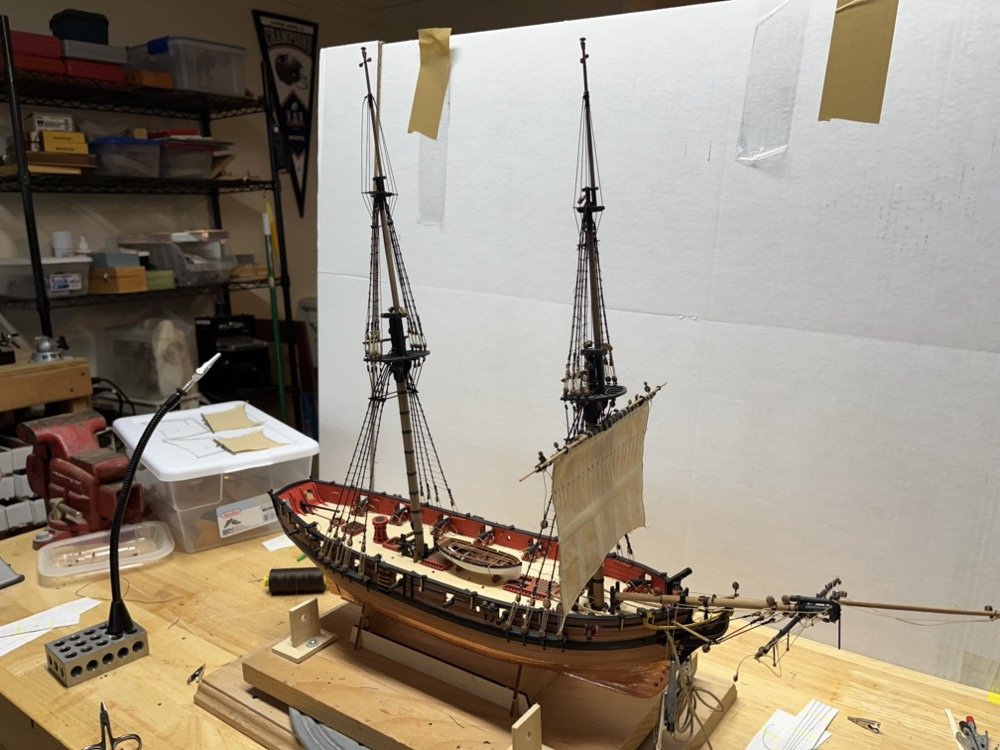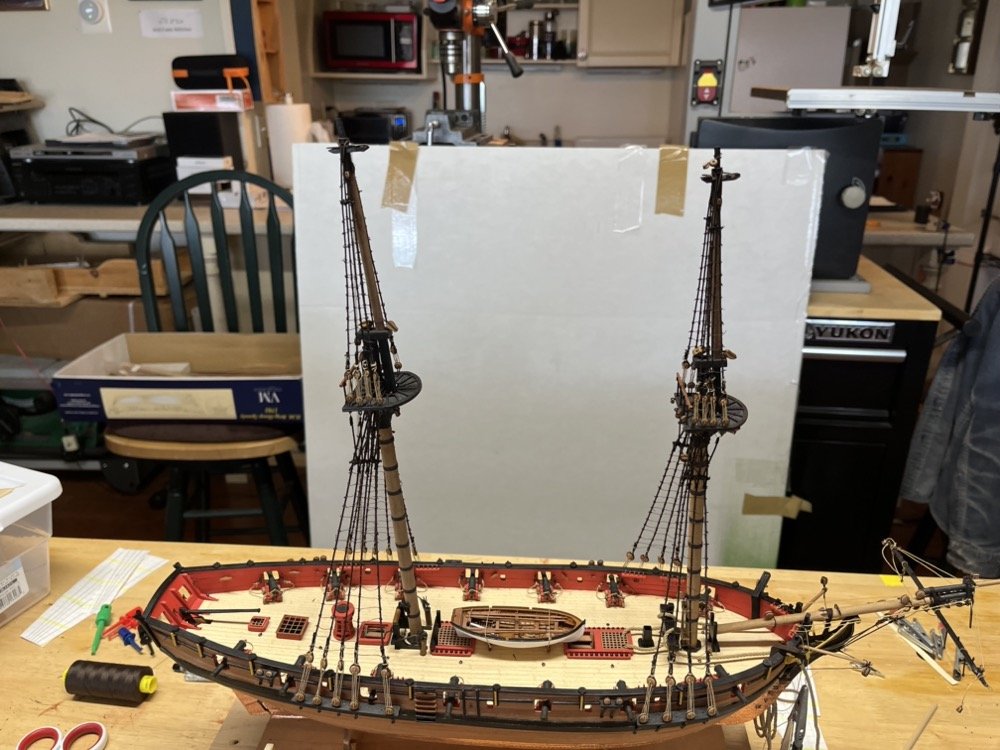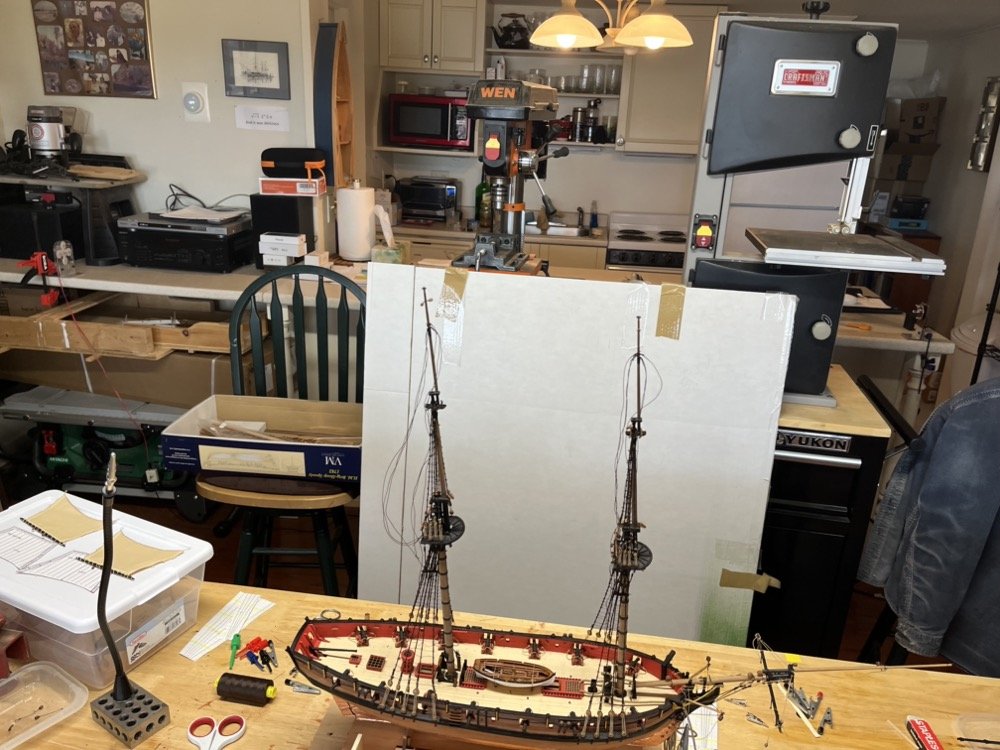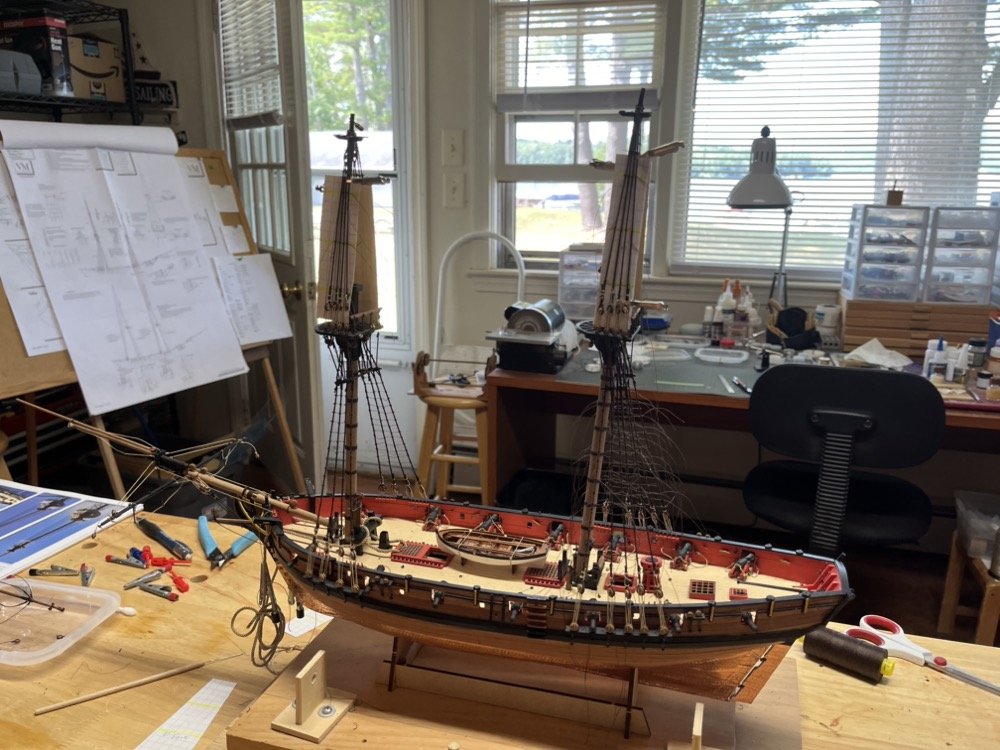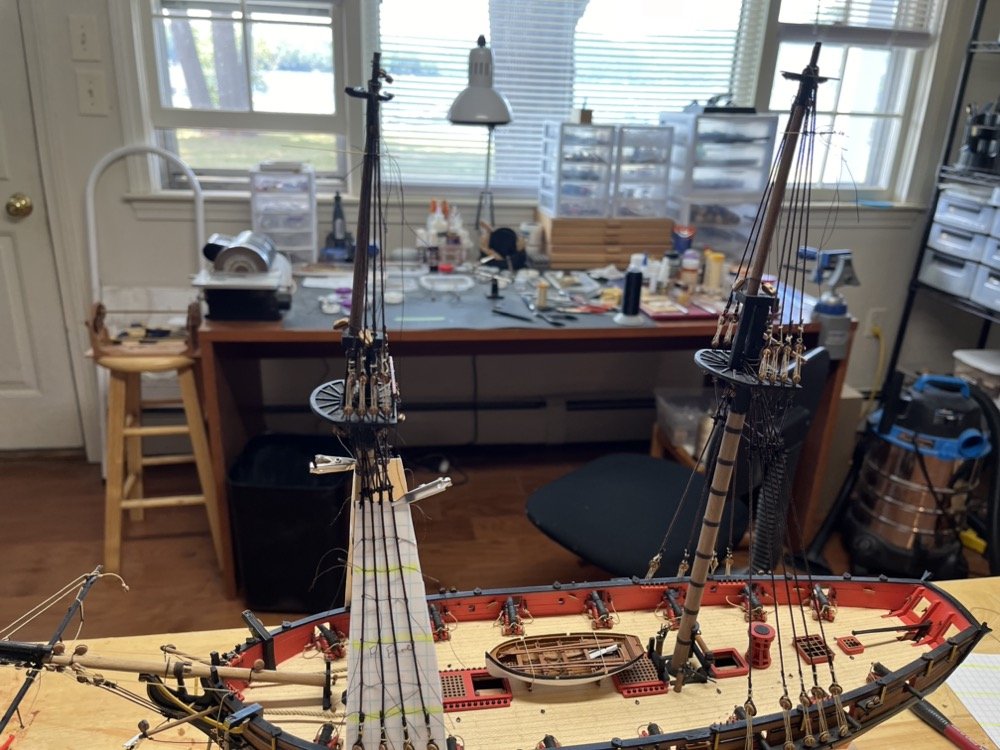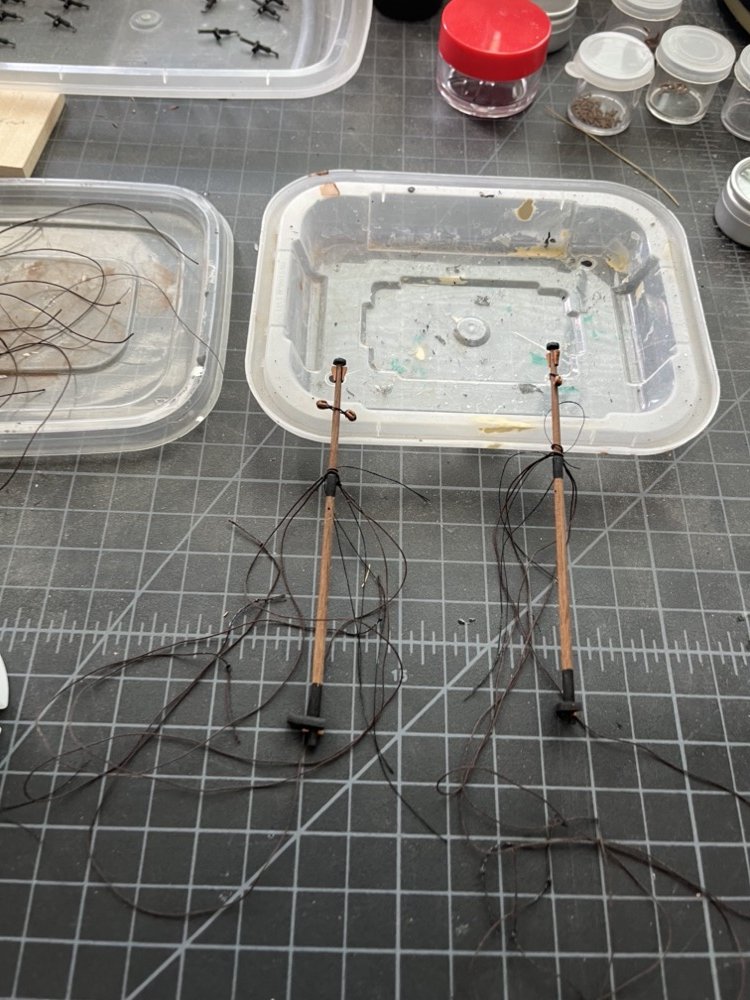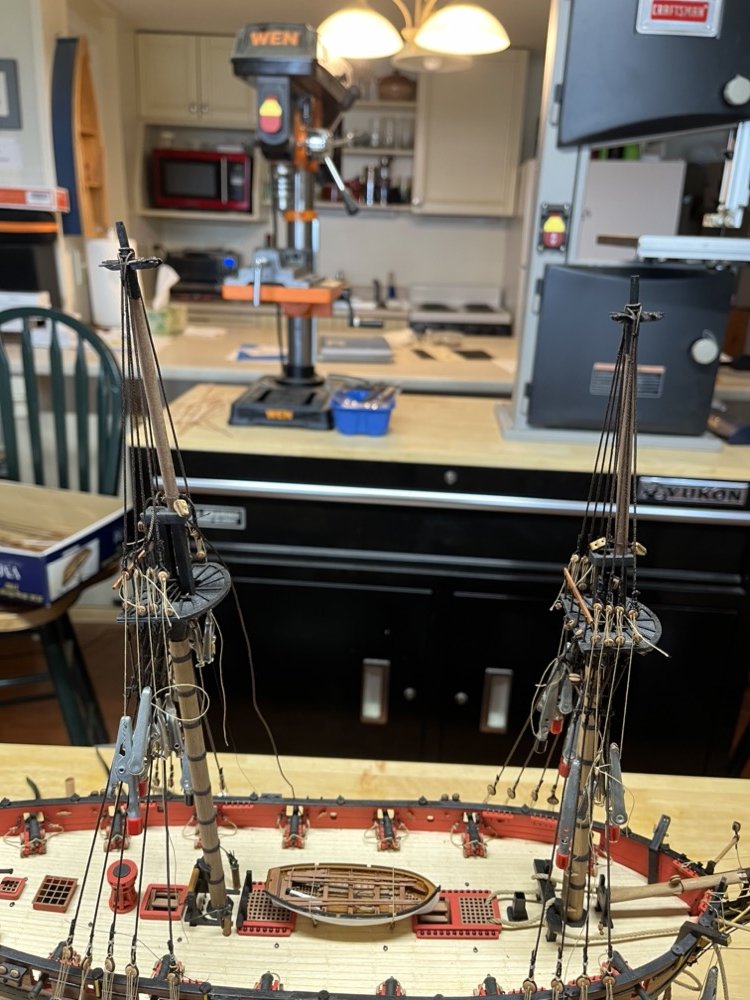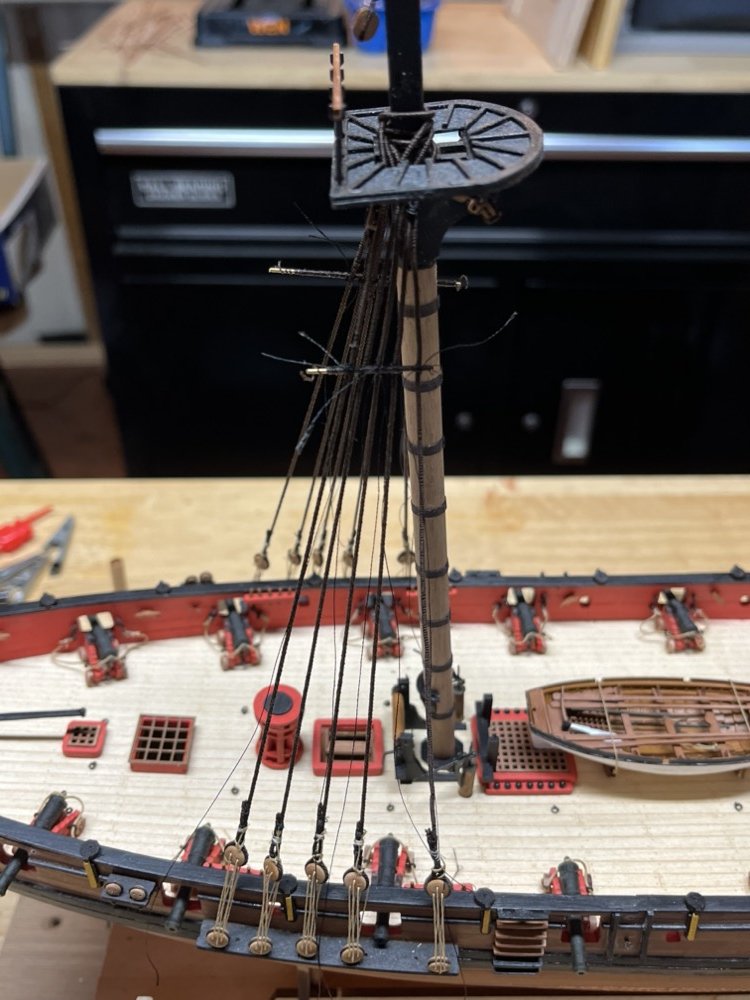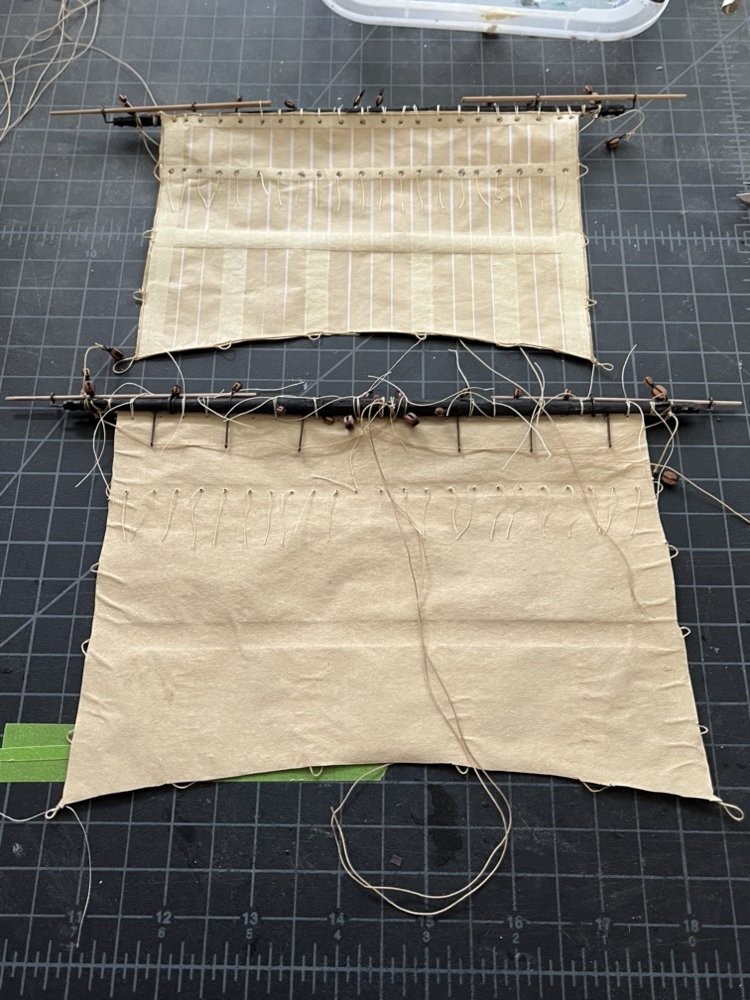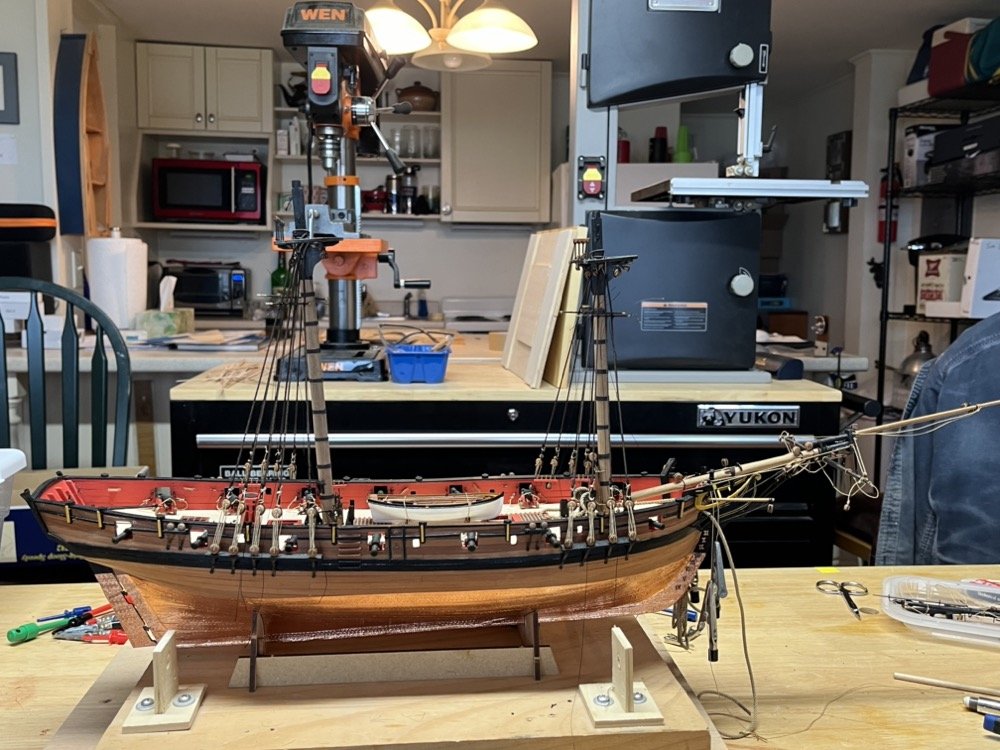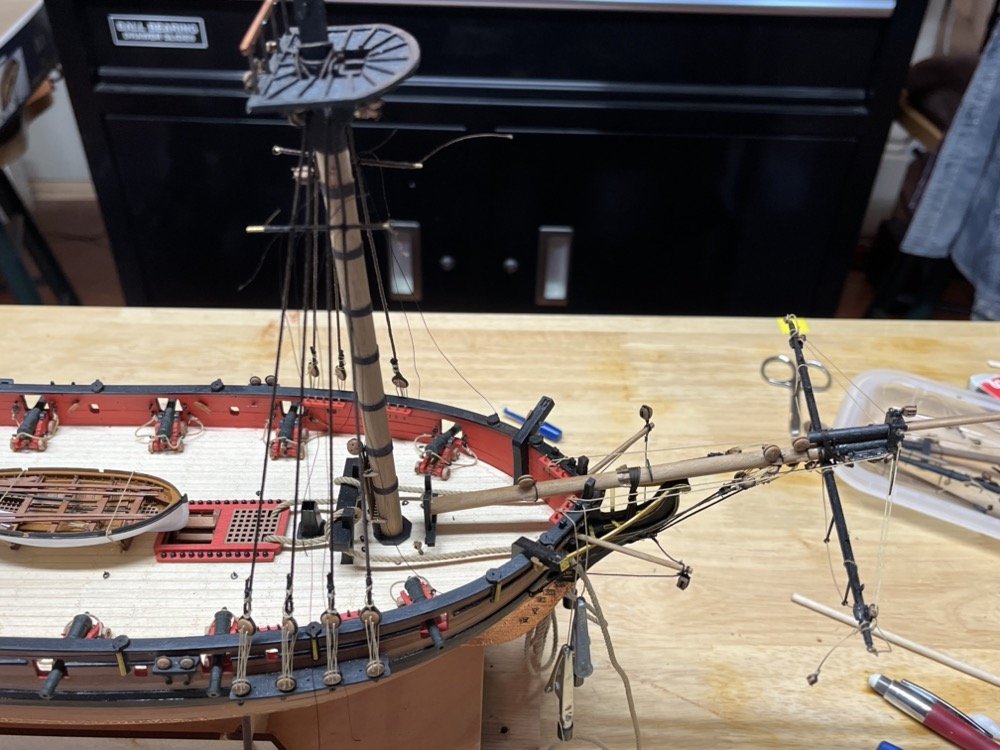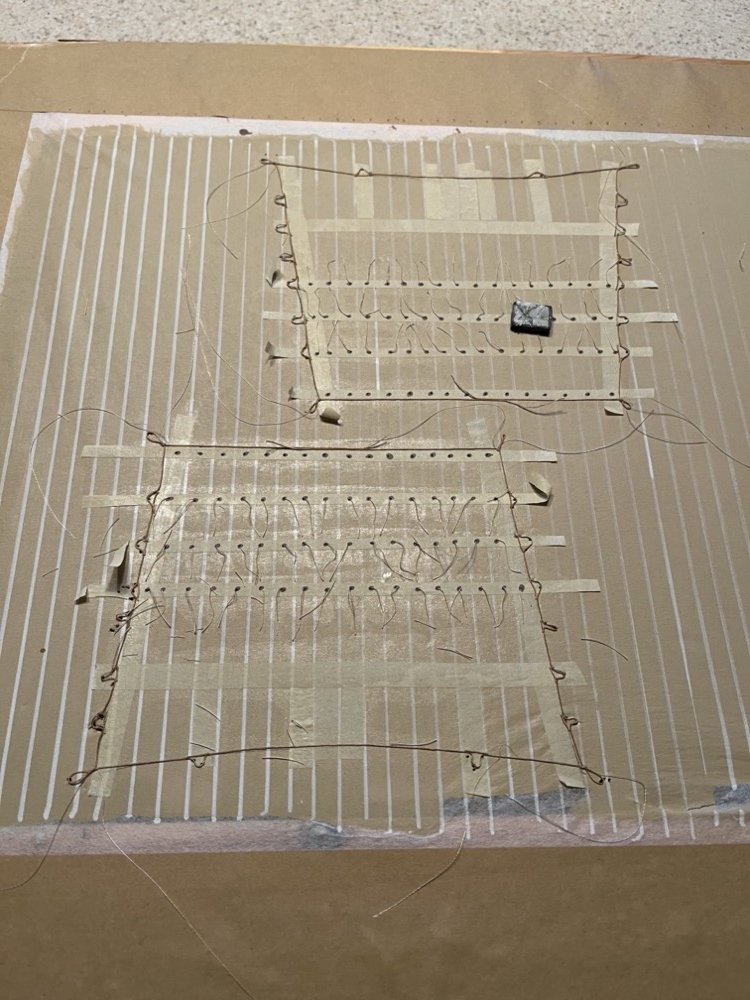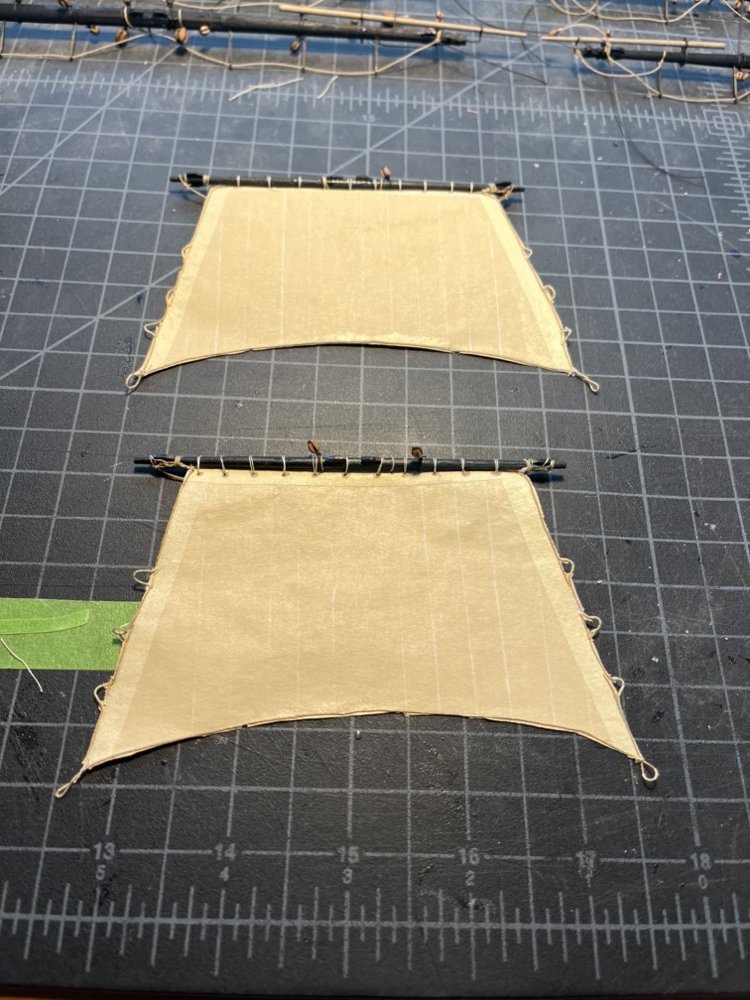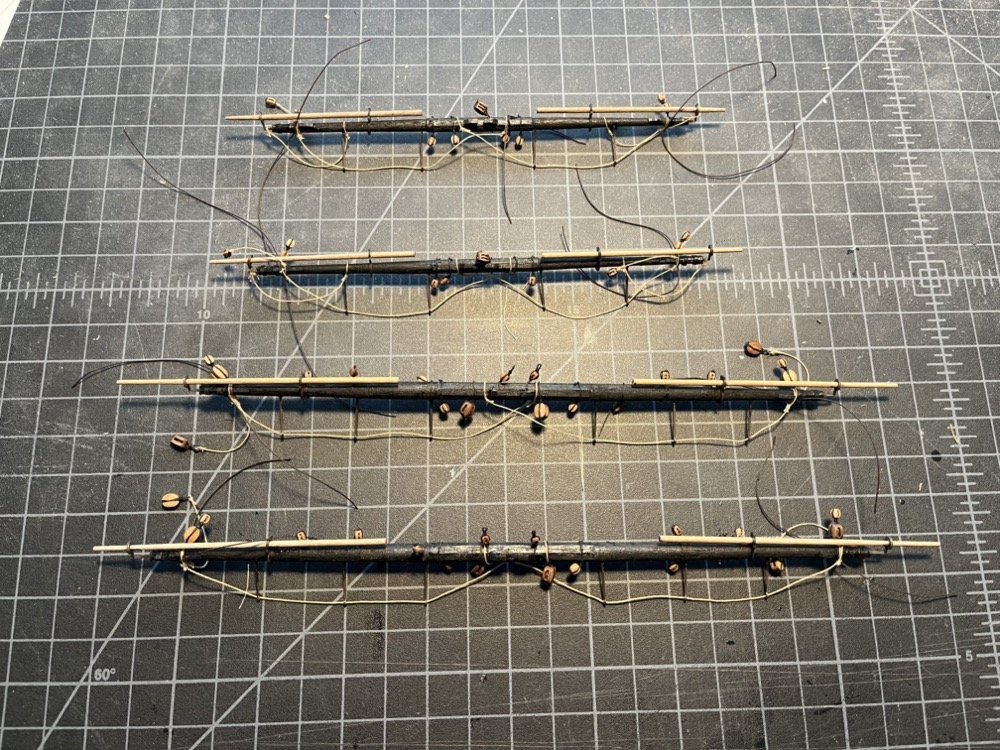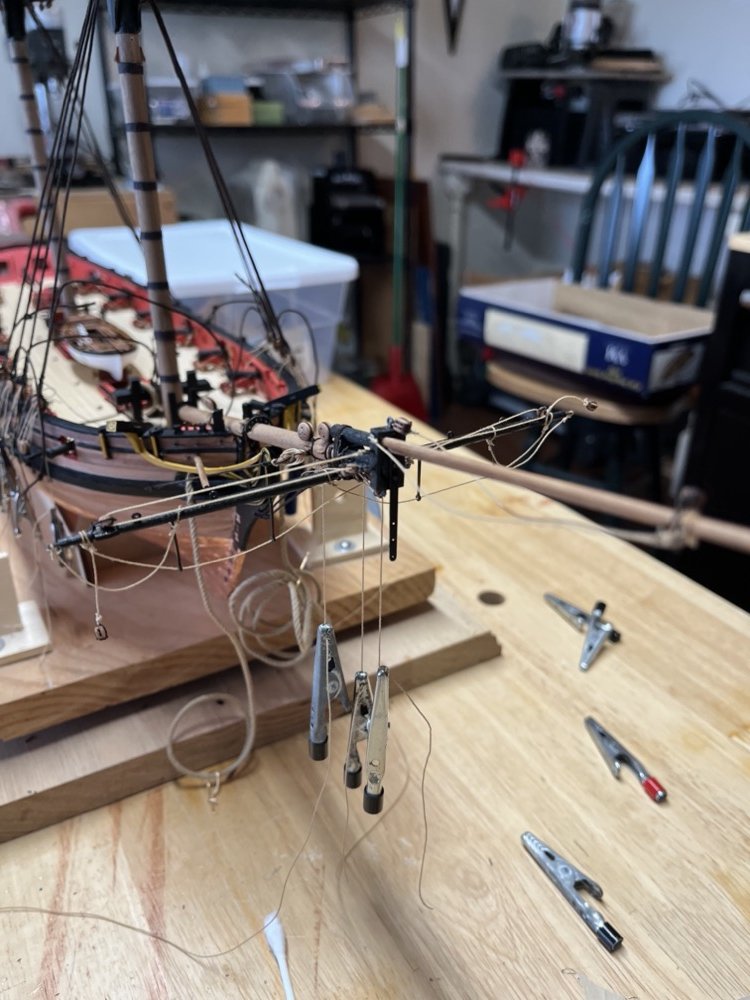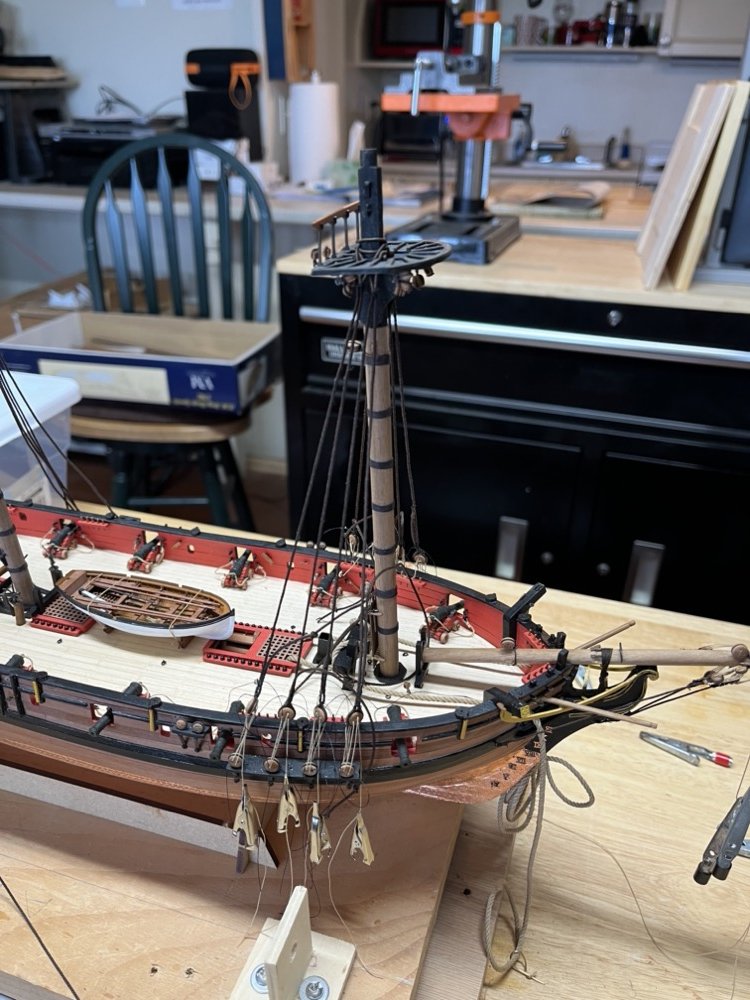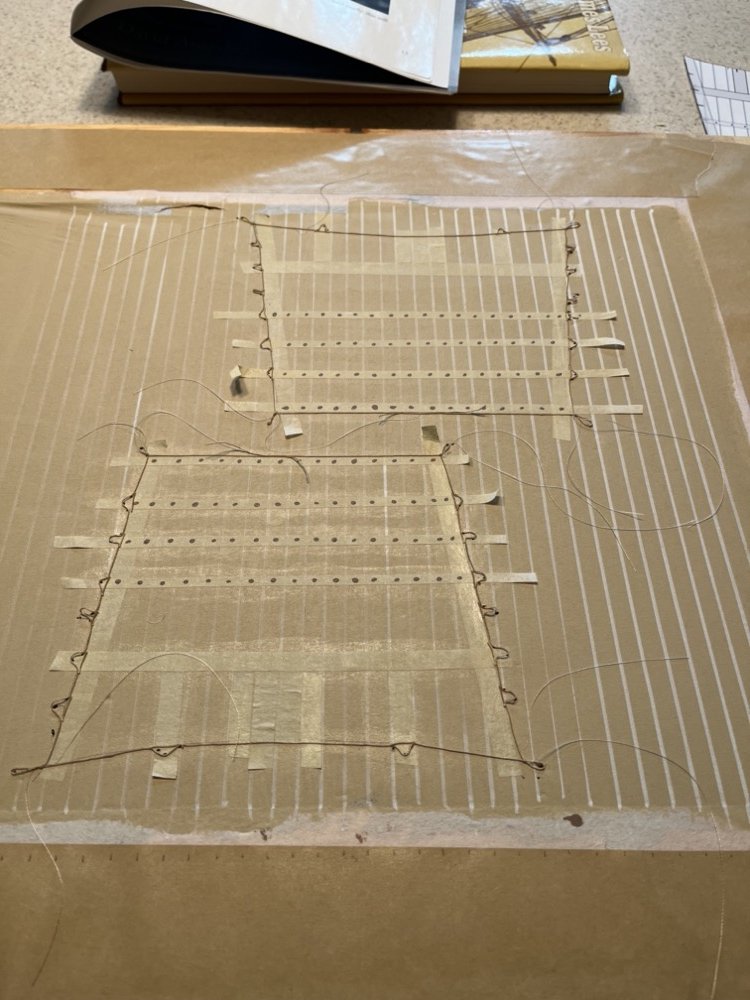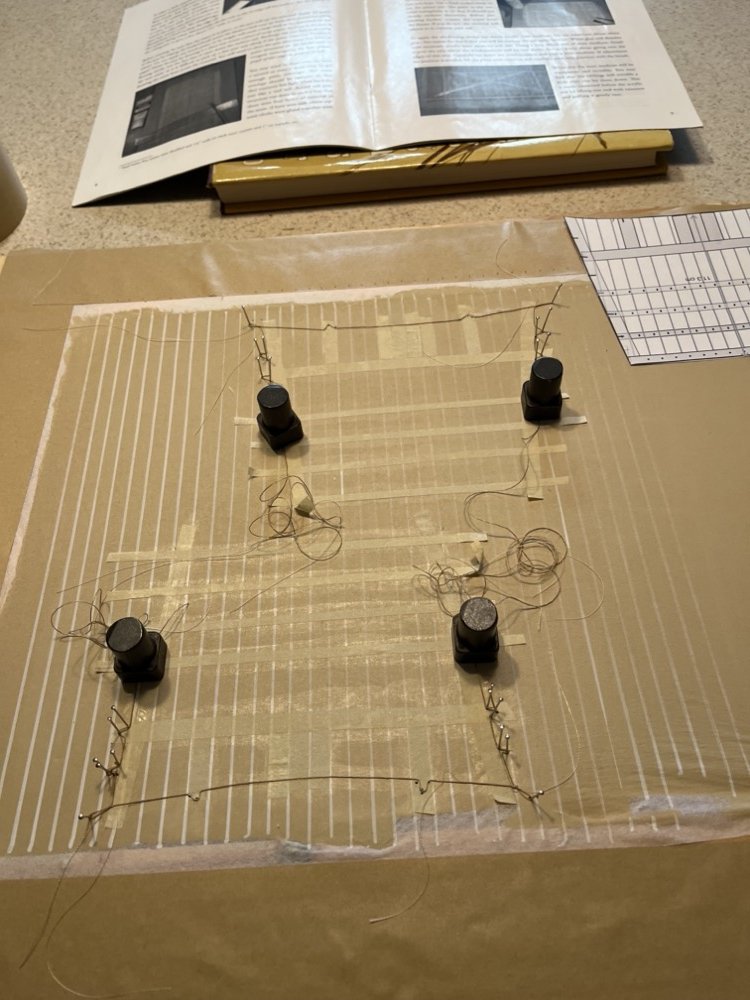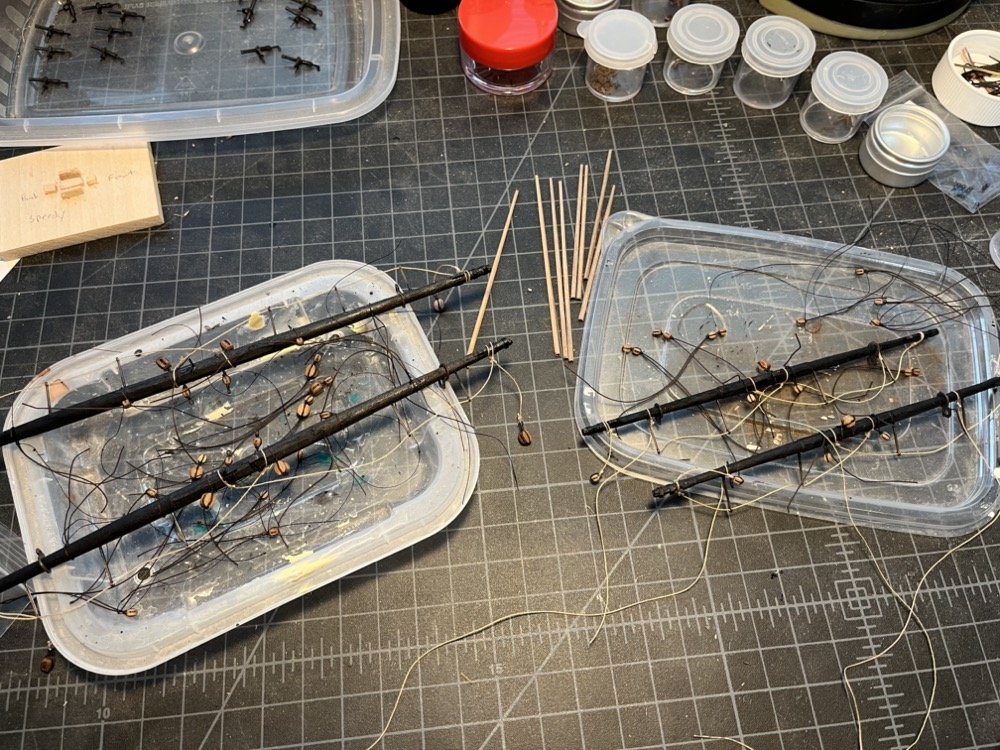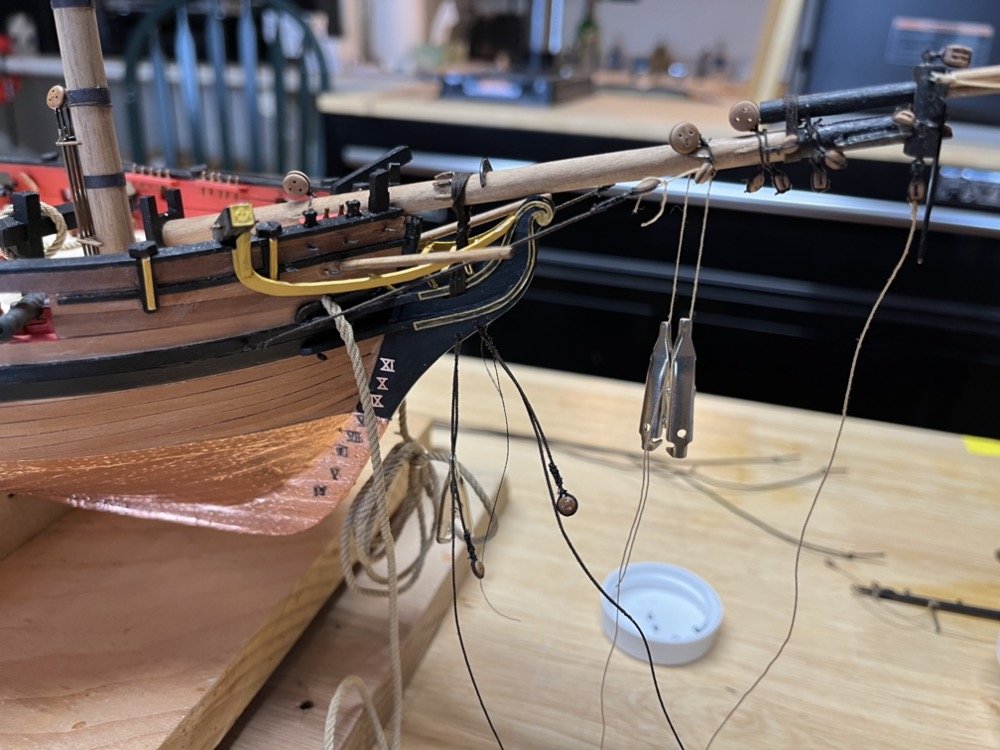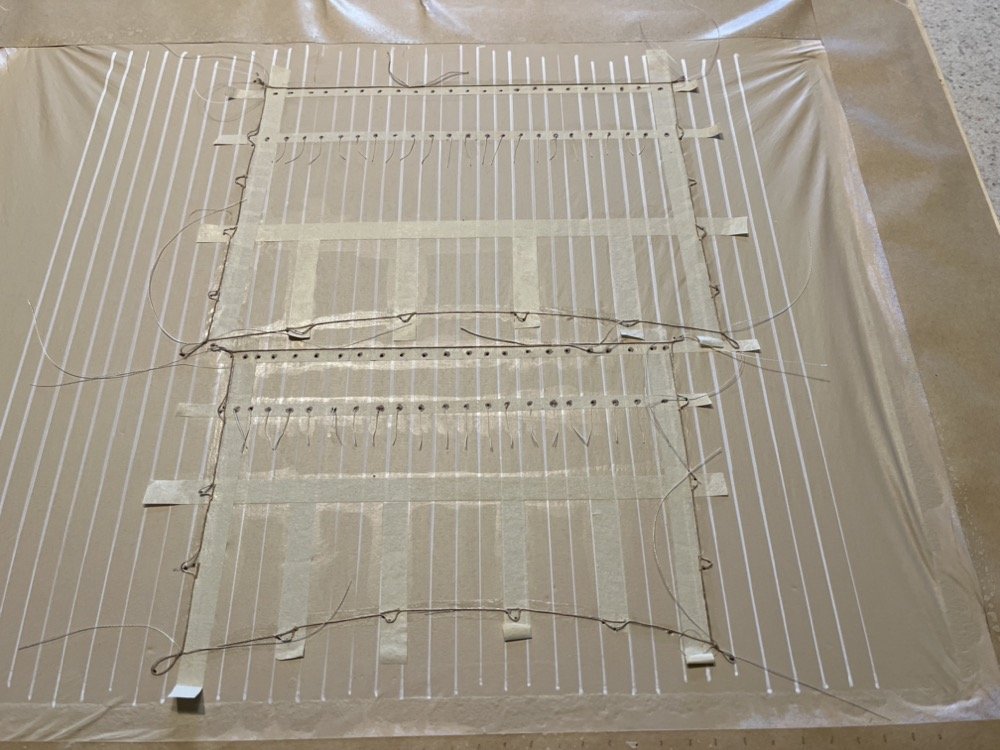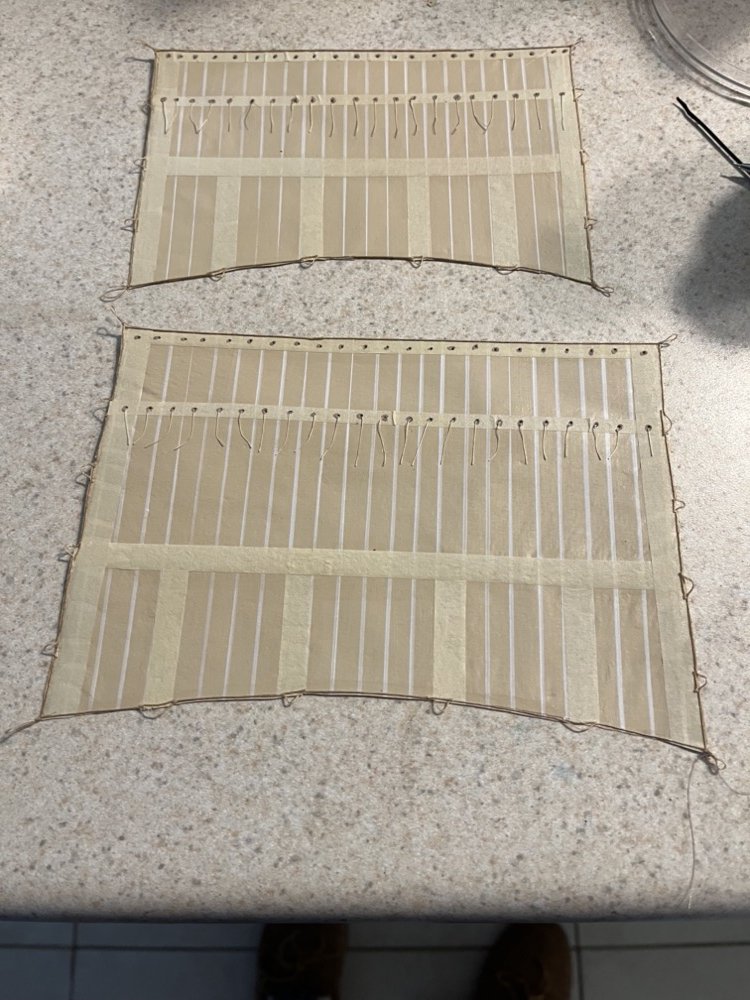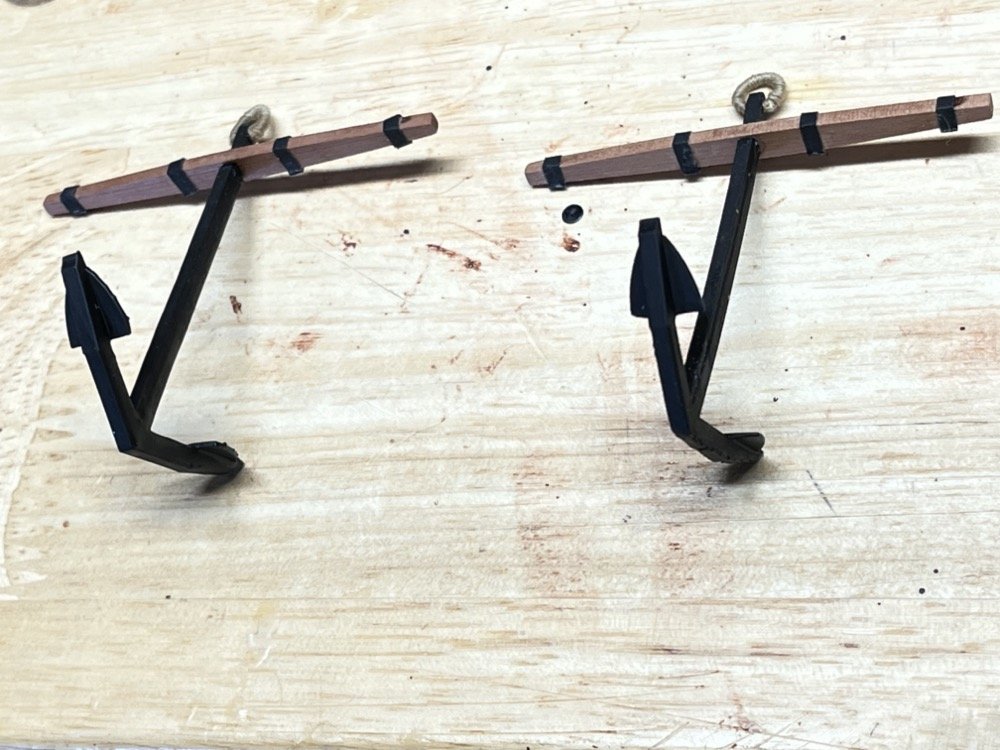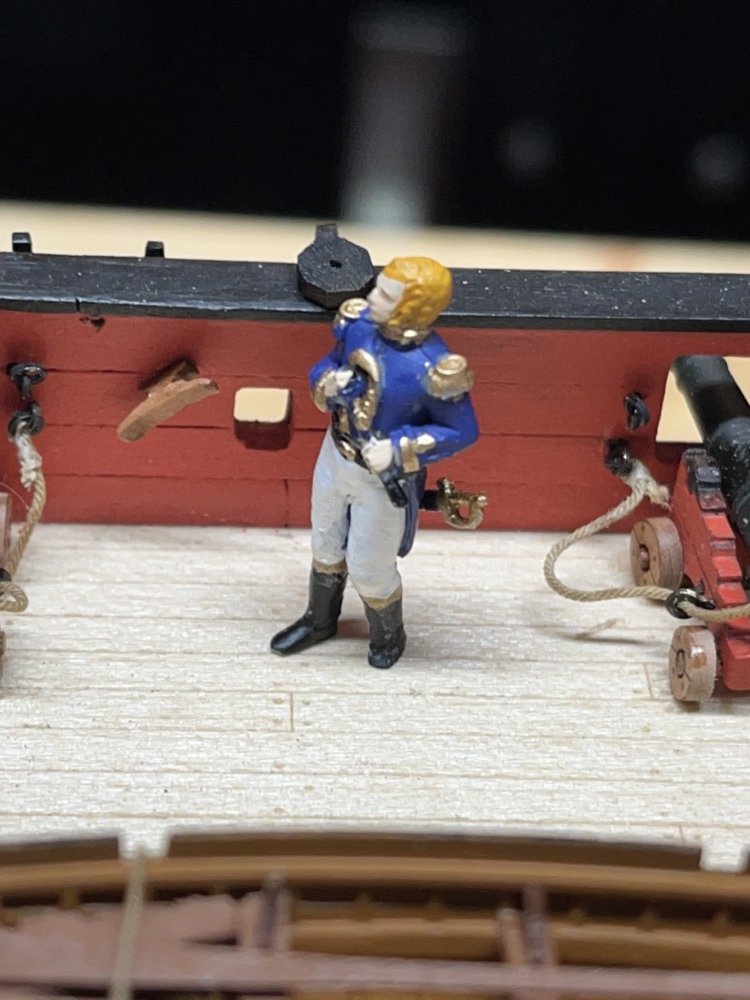-
Posts
2,407 -
Joined
-
Last visited
Content Type
Profiles
Forums
Gallery
Events
Everything posted by usedtosail
-
I am getting close to the end now. I finished making rope coils and have added them to the deck areas and belaying pins that have rope on them. I secured a few loose cannons that I bumped during the rigging process. I have tied the anchors to the anchor lines and then lashed them to the hull, both through the first gun port and the cat heads. I need to clean up the excess lines and drape the anchor lines around the fore bitts. Here is the deck area I showed in the previous post with more rope coils added. I doubt in a real ship that there would be piles of rope lying on the deck but I have no idea how else to show the excess lines that should be there. The photos in the instruction book show the lines just cut off at the bitts with no excess shown at all, which is not realistic to me. I did a search for rope coils on bitts but found nothing, so I am going to start a thread in the rigging section to see how others have dealt with this. Here is the starboard anchor lashed to the model. I am only putting one anchor on each side. Once the model is complete I will be making a case for it which should take another couple of months.
- 144 replies
-
- HMS Speedy
- Vanguard Models
-
(and 1 more)
Tagged with:
-
All the bowlines are installed and tied off. I have started adding the rope coils to the belaying pins and cleats, with only a few left to add. I have been playing around with the many lines on the bitts and how to add rope coils to them. What I came up with was to cut the excess line a little longer so the lines tied to the bitts can reach the deck, then glue rope coils on top of the lines. Here is the first layer of rope coils on the fore and main bitts. After these dry I will add more, but not as many as there are lines, as I think that would not look good. I am still making rope coils and will add them as I make them. I also need to re-glue a few cannons to the deck, and add the anchors, swivel guns, and Capt. Cochrane.
- 144 replies
-
- HMS Speedy
- Vanguard Models
-
(and 1 more)
Tagged with:
-
After almost 2 weeks away, I am back onto this model. I added the fore sail bowlines and tied them off to the fore bitts. I am now working on the main sail bowlines and still making rope coils.
- 144 replies
-
- HMS Speedy
- Vanguard Models
-
(and 1 more)
Tagged with:
-
Braces are all installed and tightened. I also added the vangs to the gaff. Next up are the bowlines. I have also been making a lot of rope coils, both to go on belaying pins and others to go on cleats and layer on the deck. I am waiting to add them until all the lines are installed.
- 144 replies
-
- HMS Speedy
- Vanguard Models
-
(and 1 more)
Tagged with:
-
I finished adding the sheets, clew lines, tacks, leech lines and bunt lines to all of the sails. I tied off the ends of all the lines so far and fixed them in place. I trimmed the lines that ended at cleats or belaying pins but not those that are tied to the fore or main bitts. There are so many lines tied to the fore bitts, as per the belaying plans on each rigging sheet, that I am not sure how to finish these off. Do I lead each line down to the deck and add a rope coil for each one, but they would have to be stacked on one another. I thought about making some bigger rope coils and draping them over the bitts but haven't tried it yet. Any ideas you guys have would be appreciated. Some of the braces are also tied to the bitts so I won't add anything until all the lines are on the bitts. I am now starting the braces and then will finish off with the bowlines. I still have the lines that go down from the ends of the gaff to add and the anchor lines to wrap around the fore bitts also. Plus adding rope coils to the lines on the belaying pins and cleats, but it is getting close.
- 144 replies
-
- HMS Speedy
- Vanguard Models
-
(and 1 more)
Tagged with:
-
I have added the sheets, tacks, and clew lines for the courses but have not tied them off yet. I used a thinner line than suggested on the plans as those lines just looked too thick. I also added the leech lines and buntlines to the courses and added the sail control lines to the jib and topmast staysail. I am currently adding the sheets and clew lines to the topsails and topG sails, and the leech lines to the topsails.
- 144 replies
-
- HMS Speedy
- Vanguard Models
-
(and 1 more)
Tagged with:
-
Thanks Andrew. I will be addressing the rat lines as they are now to see what I can do to make them look better. I may be able to replace the few worst ones and clean up the rest.
- 144 replies
-
- HMS Speedy
- Vanguard Models
-
(and 1 more)
Tagged with:
-
I finished up the rigging on the driver boom and moved on to the adding the lift lines to the yards. I started with the lower yards and worked my way up to the topG yard lifts. I think the hardest part of adding these was threading the lines down through the mast tops to the deck without having them foul other lines. I also added the jib boom guys to the bowsprit, which go through eye bolts on the sport sail yard and end with tackles hooked to eye bolts in the hull. These were pretty straight forward. I am now to the point of adding the sheets, tacks and other sail control lines. I have also been going back and replacing lines that I didn't like the look of, mostly because I had already tied them off and trimmed them but they have gone slack. I am really not happy with the ratlines. As you can see in the close up picture in the previous post, the knots have not stayed tight and many off the end knots have come loose. I may go drastic and remove them all and redo them, even though I have to work around other lines now. I have not have this problem to this degree on past builds, but I used a polyester thread on this model where I usually use nylon thread. In any case here how the model looks at this point.
- 144 replies
-
- HMS Speedy
- Vanguard Models
-
(and 1 more)
Tagged with:
-
Thank you Mustafa and the likes. All the stays and back stays are now in place and secured. I had already added the yards to the masts except for the gaff and drive boom, so those went on next. I started with the gaff which already had the driver sail bent on. I threaded the parrel line around the mast, after partially rigging the topping lift and gaff tie to hold the gaff up, and tied there parrel line off to the other side of the gaff. I then ran a line around the front of the driver sail and wrapped it around the main mast to hold the sail to the mast. At this point I finished rigging the gaff lines in preparation for adding the driver boom. I made the driver sail to be loose footed so it is only attached to the boom at the front and back. For the front attachment I added an eyebolt to the top of the boom and for the back I drilled a hole through the boom. I added the parrel line around the main mast and tied it off, then added the topping lift and tackle. I tied lines to the front and back of the sail. I threaded the back line through the hole in the boom and tied it off to the cleat on the side of the boom. I have yet to thread the front line through the eyebolt or add the sheet tackle, but here is how it looks so far. Once I finish here I'll start on the yard lifts.
- 144 replies
-
- HMS Speedy
- Vanguard Models
-
(and 1 more)
Tagged with:
-
Yes those look nice but mine won't look like that. I am going with David Antscherl's advise in the sail making supplement to the Fully Framed Model that unless you have the ship in a diorama not to have it look like it has wind in the sails. I have the main topG and royal stays in place and have bent the flying jib to the fore topG stay. I had to remove the stay from the hanks (don't ask) and replace it on this sail but I found it was pretty easy to do. The fore royal stay is also in place, but I still need to finish threading these through the blocks on the bowsprit and add the tackle lines. The fore royal stay just goes over the end of the flying jib boom, so I used a small file to file a groove into the end to help hold it in place better as it kept sliding off the end. After I get all the stays installed I am going to go through and tie off many of the lines before finishing the rigging of the yards.
- 144 replies
-
- HMS Speedy
- Vanguard Models
-
(and 1 more)
Tagged with:
-
I added the fore and main stays and preventer stays. I left the lanyards loose in the deadeyes in case I need to adjust them after the other stays are added. I then started on the topmast stays. The fore topmast stay is where the jib sail is bent so first I needed to figure out how I was going to attach the sail to the stay, since I wanted to do this on the bench and not on the model. I decided to use metal hanks so I bent a bunch from 28 gauge black steel wire. I also experimented with tying them to the sail. This is what I came up with. I started by sliding one of the hanks around the stay and pinching it closed, then looping a length of line around the two "horns". I ran the line through one of the eyelets on the sail and looped it a couple of times, then put those loops over the horns and pulled the line tight. As a final step I looped the line over the horns one more time and added a half hitch to hold it all together. After doing this for all the eyelets, I positioned the sail along the stay and fixed the knots with shellac. I looped the stay with the sail around the mast and around itself, then seized the loop into place so the sail was at the right height and fixed the position of the mouse. I then threaded the other end of the stay through the bees and seized the tackle to the stay. The other topmast stays were more straight forward because they didn't have a sail on them. Next up are the topG and royal stays.
- 144 replies
-
- HMS Speedy
- Vanguard Models
-
(and 1 more)
Tagged with:
-
They will get a little more shape once the sheets, tacks and bowlines are added but I don't plan to shape them like they are full of wind.
- 144 replies
-
- HMS Speedy
- Vanguard Models
-
(and 1 more)
Tagged with:
-
I have all the yards installed now with the parrels and yard ties. I am also finishing up the back stays and flying back stays, so I am preparing for the stays and preventer stays. I wanted more realistic looking mice than the supplied beads, so I chucked a piece of pear wood in the lathe and turned 4 large and 4 smaller mice. After I cut these off I stained them to darken them and reamed out the holes to fit the lines for the stays.
- 144 replies
-
- HMS Speedy
- Vanguard Models
-
(and 1 more)
Tagged with:
-
Thanks Tom. I have to add some running rigging now when adding the yards, but I still have a lot of standing rigging to add. After securing the main and fore yards to the masts using the trusses and the ties, I added the main yard and topsail yards next. I also had to fix some things that I wasn't happy with as well as fix some mistakes, like forgetting to add the blocks that hang from the upper crosstrees before I added the topG shrouds. I had them all ready to go so I only had to slip them on before threading the shrouds, but now I had to strop them in place instead. Not too hard to do but just annoying. I have added the parrels and parrel beads to the main and fore topsail yards and I didn't even drop any of the pieces during installation, which is a first for me. You can see the how I added the line to one side of the yard, threaded everything, and then wrapped the whole assembly around the masts and tied them to the other side. You can also see the ties that hold these yards up. I haven't added the tackle lies to these next but will wait until later when they won't get in the way of the other rigging. I pinned the lower and topsail yards to those masts which helped keep them in place during their rigging. I have now also added the topG yards which have a tie line that goes through a hole in the topG masts. I did not pin these to the masts because they are pretty thin and I didn't want to compromise them with another hole. The parrel beads are hanging from one side of the yards and ready to be threaded around the topG masts. I may wait to add the gaff and driver boom until later so I can reach into the center of the deck easier, so I may add the backstays next.
- 144 replies
-
- HMS Speedy
- Vanguard Models
-
(and 1 more)
Tagged with:
-
I threaded the topG shrouds through the crosstrees after reaming the holes in the crosstrees so the line would fit. I then tied them off on the topmast deadeyes and trimmed the excess line. The instructions now have you add the yards then the backstays and mast stays. Since I have bent the sails to the yards I am going to have to work around them as I add the rest of the rigging.
- 144 replies
-
- HMS Speedy
- Vanguard Models
-
(and 1 more)
Tagged with:
-
I found a better background for these rigging photos so hopefully it will be easier to see the progress. I finished adding the topmast ratlines and trimmed all the excess lines. I had already added the topG shrouds to the topG masts, so I glued the masts in place and will run the shrouds through the crosstrees when it dries. I also trimmed the topmast futtock staves and painted them black.
- 144 replies
-
- HMS Speedy
- Vanguard Models
-
(and 1 more)
Tagged with:
-
I have finished adding the ratlines to the lower shrouds, except for trimming the excess line from the main shroud ratlines, and I have started adding the ratlines to the topmast shrouds.
- 144 replies
-
- HMS Speedy
- Vanguard Models
-
(and 1 more)
Tagged with:
-
Thanks Tom. I have bent all the sails to the yards so they would be a hindrance for me, but if you have no sails you should be fine.
- 144 replies
-
- HMS Speedy
- Vanguard Models
-
(and 1 more)
Tagged with:
-
I had added the topmast futtock staves and the catharpins, then tried seizing the small single blocks between the first two shrouds on each side. I had served a piece of .5mm brass rod for the staves. I was having all kinds of problems getting those blocks in because I did not leave enough room above the staves, and the seizings on the served rod just looked a mess. So, I removed all that and started again. This time I first seized all the blocks to the shrouds, and now I am adding the staves and the catharpins. I am using unserved brass rod for the staves with less loops on the seizings. So far it is going and looking much better. While waiting for things to dry I have started adding the ratlines to the lower shrouds. I also served lines for the topG shrouds and am adding them to the topG masts off the model. I had to ream out the holes in the topG crosstrees to make sure the shrouds will fit in the holes when I install these masts.
- 144 replies
-
- HMS Speedy
- Vanguard Models
-
(and 1 more)
Tagged with:
-
Great job, especially for your first build.
- 152 replies
-
- Flirt
- Vanguard Models
-
(and 1 more)
Tagged with:
-
Just a quick update. I have been working on adding the topmasts and topmast shrouds. I need to tie off the lanyards and add the futtock staves. There are also blocks tied into the first two topmast shrouds on each side.
- 144 replies
-
- HMS Speedy
- Vanguard Models
-
(and 1 more)
Tagged with:
-
After a short trip to New Orleans and some beautiful summer weather here in New England, work on Speedy continues a few hours each day. So as of today I have finished adding and trimming all three rows of reef points to the two topsails, with only a few that need some additional attention. These are ready to be cut out from the panel. I have also bent the fore course to the fore yard and I am in the process of bending the main course to the main yard. I have added the fore and main shrouds to both masts, adjusted their lengths and tied the lashings off. I am in the process of adding the futtock staves to them, using served brass rod. The bumpkins have also been rigged . Here is how the model currently looks. Have a nice weekend.
- 144 replies
-
- HMS Speedy
- Vanguard Models
-
(and 1 more)
Tagged with:
-
I was able to get a lot done this week. Firstly I finished added the bolt ropes and grommets to the topsails so I can now add the reef points to finish them up. I also finished bending the topG sails to the topG yards. The topsail and lower yards are now completed, with all the blocks, man ropes and studding sail booms installed. I added the spritsail yard and rigging to the bowsprit. And have the fore shrouds seized to length and the lanyards threaded. I am in the process of adding the rigging to the boomkins, finishing up the fore shrouds, and starting to rig the main shrouds.
- 144 replies
-
- HMS Speedy
- Vanguard Models
-
(and 1 more)
Tagged with:
-
I have a good start on the last two sails which are the topsails. I am currently working on adding the bolt rope. I don't know why I didn't think of this for the previous sails but for these I started adding the bolt ropes from the middle of the bottom of the sail so I could work on both sides up to the top of the sail. This will speed up this process by half. These sails have three rows of reef points so they will take a while to add. I am still adding blocks and man ropes to the topsail yards and lower yards, although they are almost done. The studding sail booms will be added after all the blocks are on. I have put the bowsprit in place and added the gammoning. I am in the process of adding the bob stays and bowsprit stays. I have the bob stays temporarily tied to the deadeyes on the bowsprit so I can get them all even. I have the lower shrouds for the fore and main masts served and ready so I will be adding them soon too. I will also be tying the topG sails to the completed topG yards to get that process started.
- 144 replies
-
- HMS Speedy
- Vanguard Models
-
(and 1 more)
Tagged with:
-
Thanks Tom and Mugje and the likes. More progress to show. I finished making the fore and main courses, then carefully cut them off the frame. The topsails will be next to be made. I painted the Captain Cochraine figure, although I have never painted anything like this before. I think it came out respectable. I used a disc sander to remove most of the base, then an X-Acto knife to cut the rest away from around the boots. Here he is just placed on the deck temporarily, wondering when the rigging will get done. He has been put away until much later. I gave him yellow hair as a nod to Captain Aubrey. Finally I have competed the anchors. I made all four but have decided to only put two on the ship. I picked the two best then wrapped line around the rings (puddened?). These have also been put away until later. Work continues on the yards. I have the PE parts installed on all of them and am in the process of painted them black. I will then add the blocks and man ropes to them. I have also been making rope in preparation for rigging the shrouds and backstays. It is all starting to come together now.
- 144 replies
-
- HMS Speedy
- Vanguard Models
-
(and 1 more)
Tagged with:
About us
Modelshipworld - Advancing Ship Modeling through Research
SSL Secured
Your security is important for us so this Website is SSL-Secured
NRG Mailing Address
Nautical Research Guild
237 South Lincoln Street
Westmont IL, 60559-1917
Model Ship World ® and the MSW logo are Registered Trademarks, and belong to the Nautical Research Guild (United States Patent and Trademark Office: No. 6,929,264 & No. 6,929,274, registered Dec. 20, 2022)
Helpful Links
About the NRG
If you enjoy building ship models that are historically accurate as well as beautiful, then The Nautical Research Guild (NRG) is just right for you.
The Guild is a non-profit educational organization whose mission is to “Advance Ship Modeling Through Research”. We provide support to our members in their efforts to raise the quality of their model ships.
The Nautical Research Guild has published our world-renowned quarterly magazine, The Nautical Research Journal, since 1955. The pages of the Journal are full of articles by accomplished ship modelers who show you how they create those exquisite details on their models, and by maritime historians who show you the correct details to build. The Journal is available in both print and digital editions. Go to the NRG web site (www.thenrg.org) to download a complimentary digital copy of the Journal. The NRG also publishes plan sets, books and compilations of back issues of the Journal and the former Ships in Scale and Model Ship Builder magazines.



